M.S. Baloeran 1930-1940 – Nazi Ship “Strassburg” 1940-1943
Please Note: Firefox and some other Search Engines may not be suitable
Use Google Chrome for this Web Page to load perfectly!
Please Note:
All ssMaritime and other related maritime sites are 100% non-commercial and privately
owned, thus ssmaritime is NOT associated with any shipping company or any other
organisation! Although the author has worked and has been involved in the
passenger shipping industry for well over 60 years, but due to his old age and
poor health, he was forced to retire. Yet, he has completed well over 1,435
Classic Liners, Passenger-Cargo Liners as well as humble converted C3 converted
Migrant Liners, which has transported countless thousands of folk to the new
world, as well on vacations’. I trust the features online will continue
to provide Classic Liner and Ship enthusiasts both the information they are
seeking, but more so provide a great deal of pleasure and relive many happy
memories!
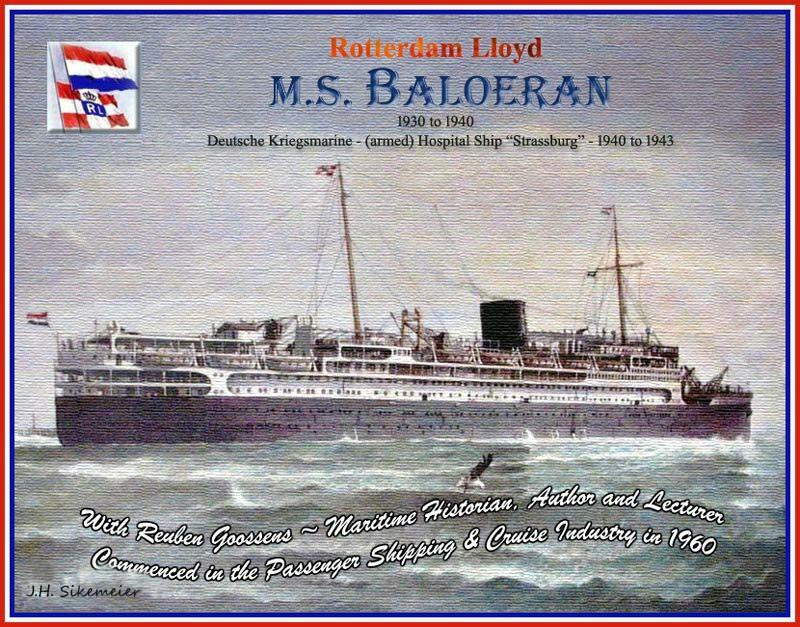
Postcards, photographs & other images are either from the author’s private collection or from my supporters.
Thus a very thank you to three very special ssmaritime supporters for sending me their wonderful
photographs & images for I could not have completed this feature to this point.
I am sorry but some of the images shown may not be of the highest quality, but they are the best that were available
Introduction in Brief:
The M.S.
Baloeran was a passenger Liner that operated to the Dutch
East Indies (today’s
*********************
Construction:
This fine Liner was
designed by Master builders “N.V. De Schelde” at Flushing (
As soon as the new
liner’s plans having been completed the order was given to ship
“Fijenoord N.V.”, on May 10, 1928, and her keel was laid down
on August 26, 1928, in Yard No 313 where she was constructed. Although, her engines were built by “N.V. De
Schelde” Machinery Factory,
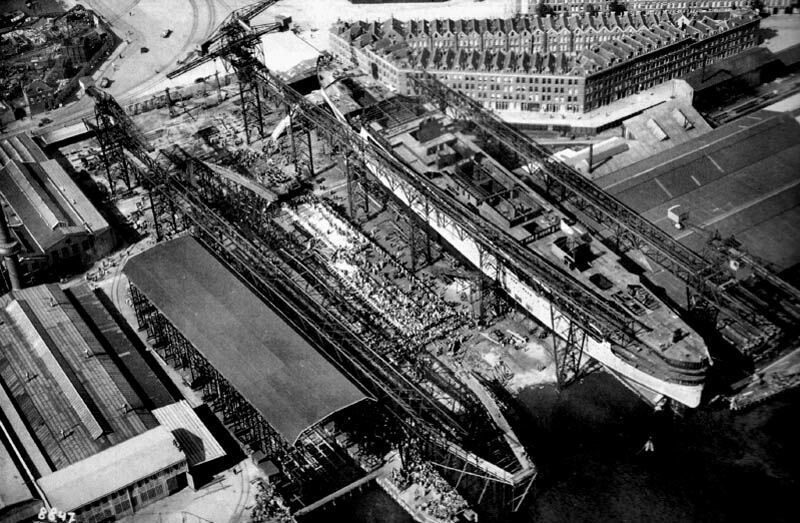
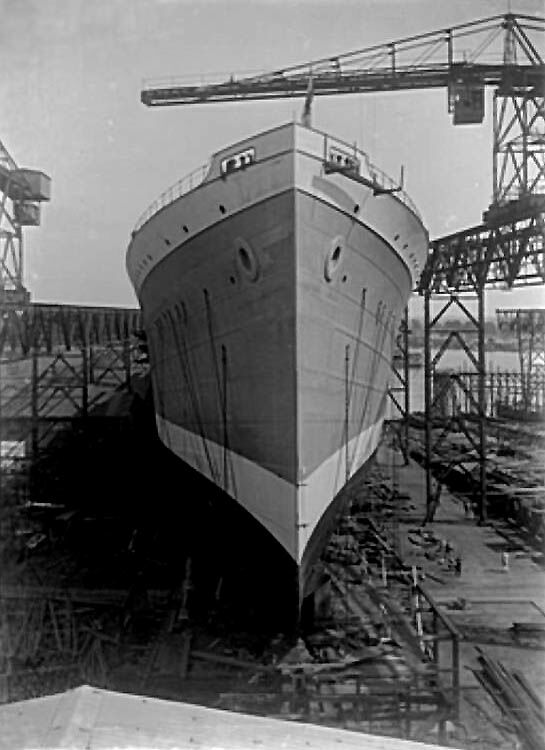
The christening and
launching of the ship on August 29, 1929, was performed by Mrs. H. Drooglever Fortuyn-Bruinier who
was the wife of the Mayor of
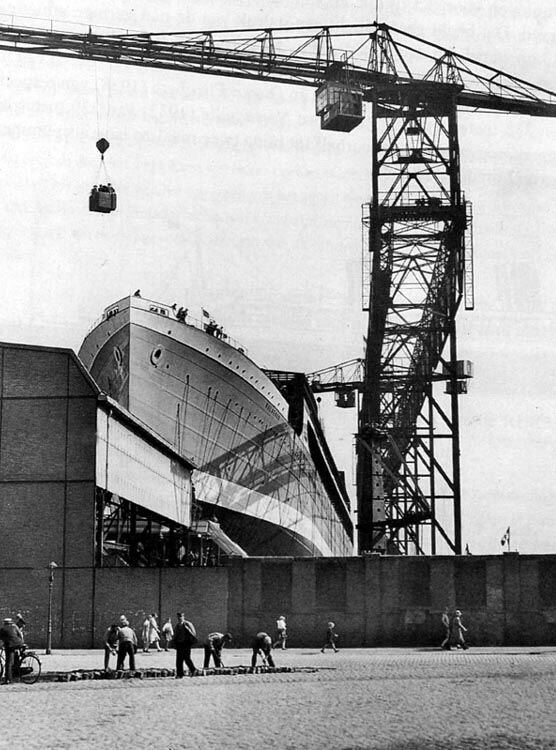
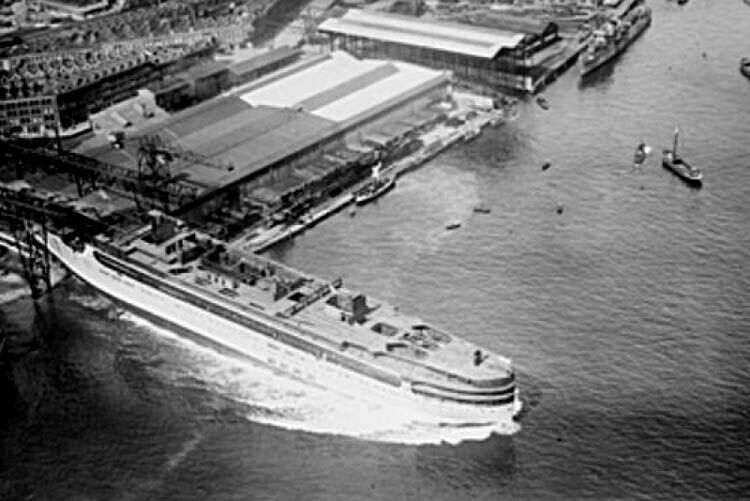
Above &
below: Photographs of the launching of the
“Baloeran”
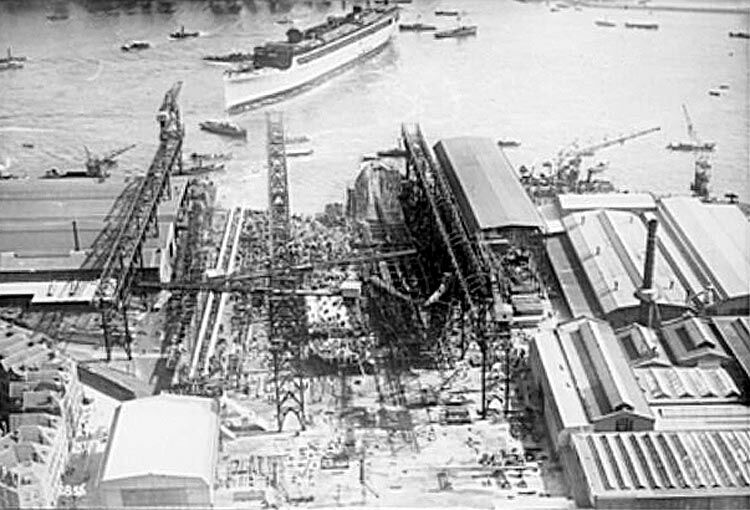
This a very rare aerial photograph of the Baloeran having just entered the water
and tugs are attempting to get the lines fixed in order to take her in tow
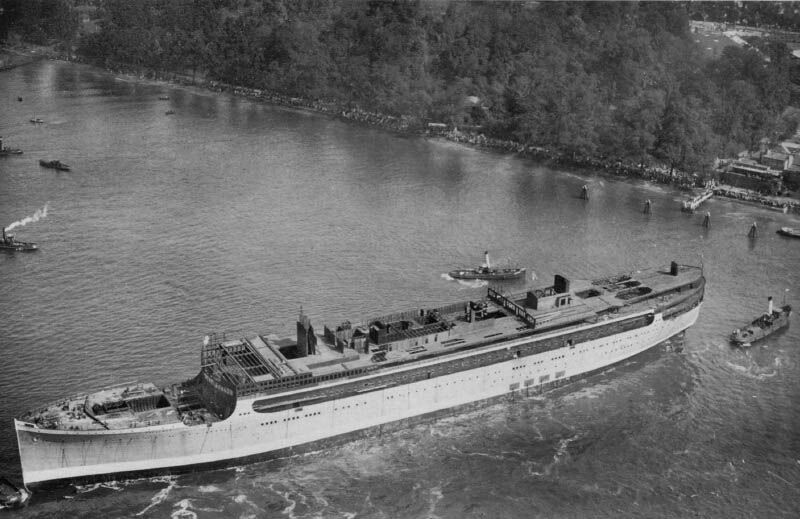
And here is a close up of the tugs are still working to get the lines fixed to get
her to the “Fijenoord” Shipyard’s Fit-out berth where
she will be completed
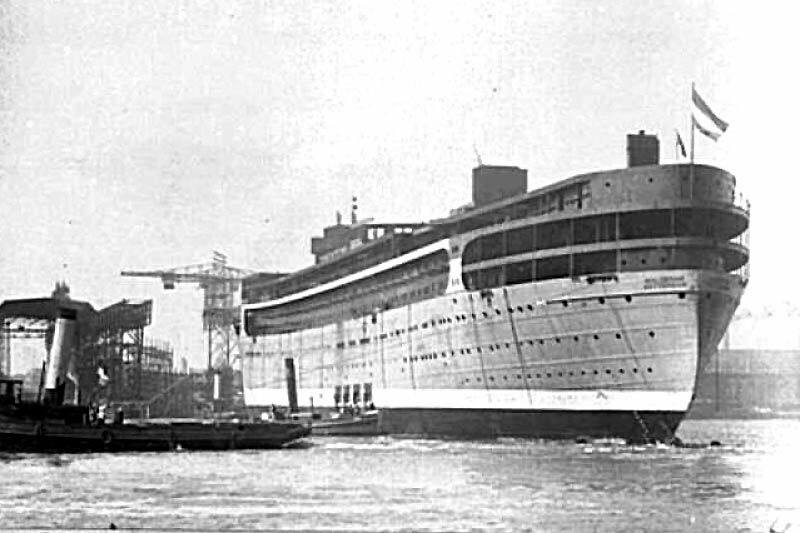
The Baloeran is
seen arriving at her fit-out berth
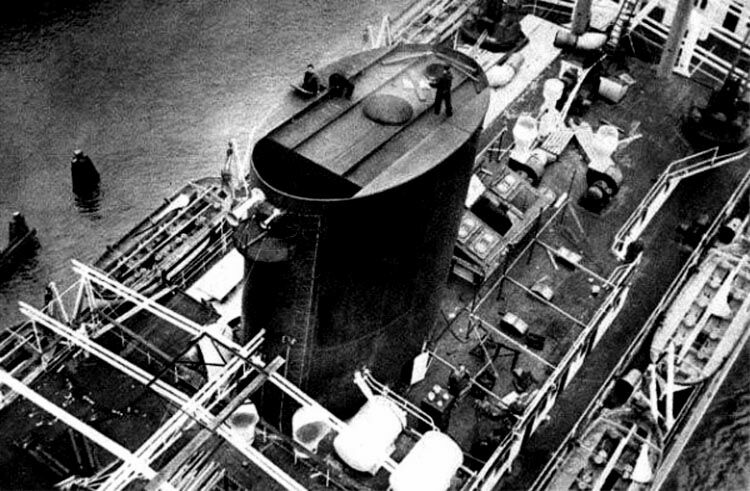
Above &
below: Work is ongoing as her fit-out continues,
but soon she will be completed
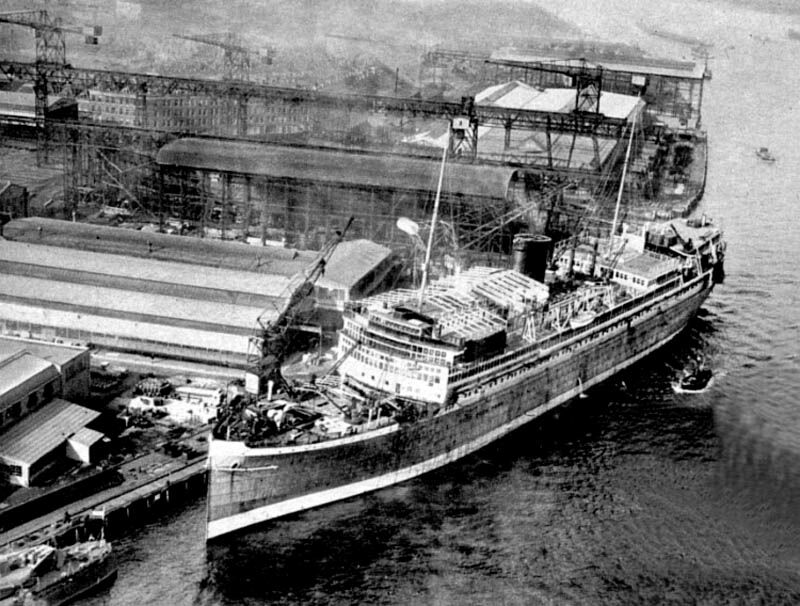
Her decks and interiors would soon be completed and her top decks added as well as all the furnishings and the fine details being carefully attended to by the specialists that were employed, whilst masts and her funnel were also installed. She began to look like a fine liner!
Her Engine Room:
As I stated earlier her
engines were built by the Dutch manufacturer “N.V. De Schelde” Machinery
Factory at
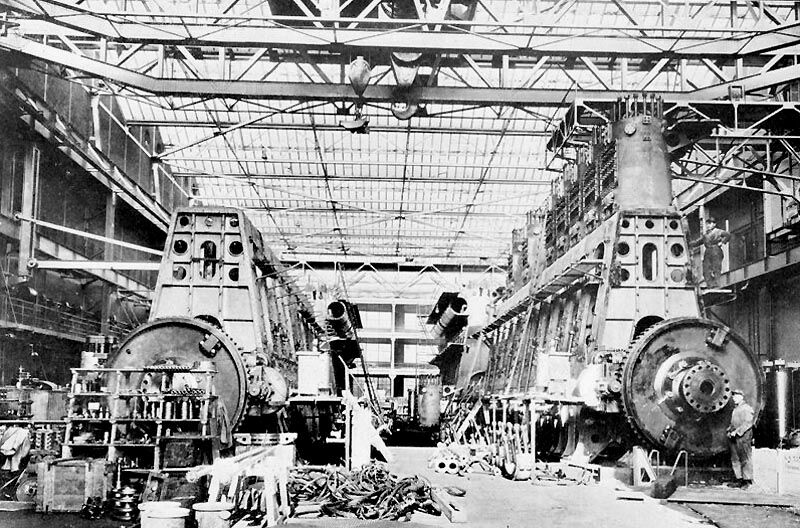
Here see two
“De Schelde Sulzer” engines being constructed at their yard at
Right is the engine for the M.S Dempo (1931) & left is the one for the M.S Baloeran
They installed into her
2 single acting 10 cylinders “De Schelde Sulzer” 10ST76 2
cycle engines producing 7,000 HP each at 100 RPM, and as her auxiliary engines
were; 4 x 6SS38 engines totalling 3,120 hp at 170 rpm.
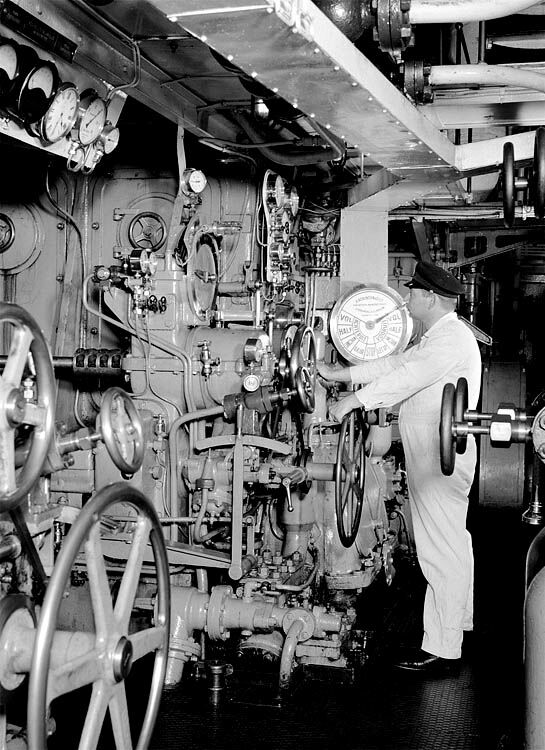
This is the Engine
Room Starting Platform
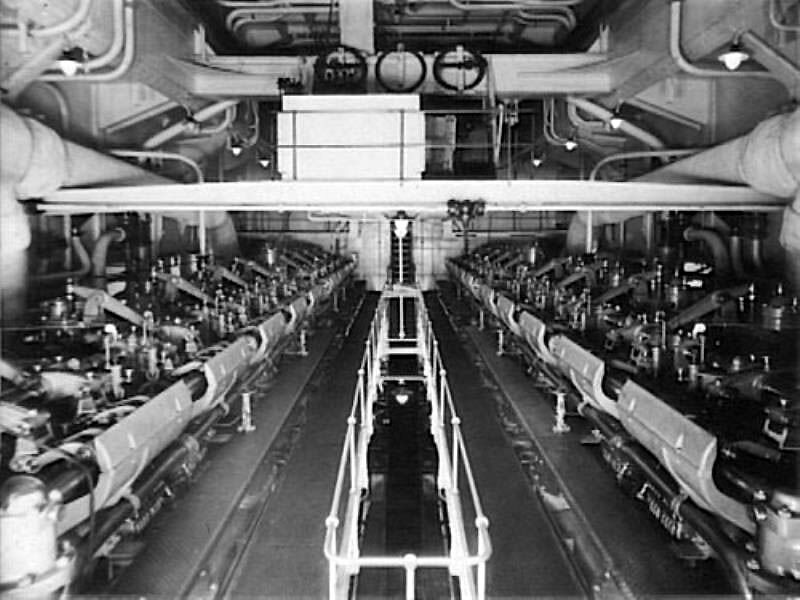
An overall view of
the engine room
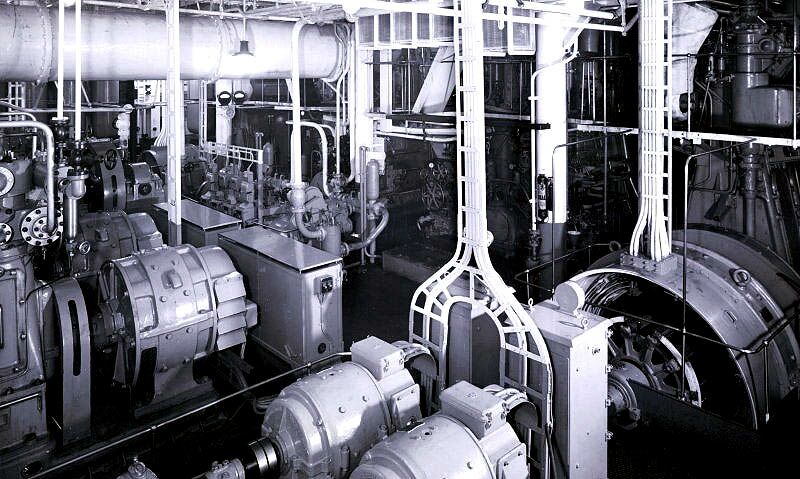
Here we see her generators
With her two screws she had a maximum speed of 18.8 knots, but generally she would operate at a service speed of 18 knots.
Sea Trials, Delivery & her Maiden Voyage:
She was completed on March 22, 1930 and departed and headed out via
the canal between
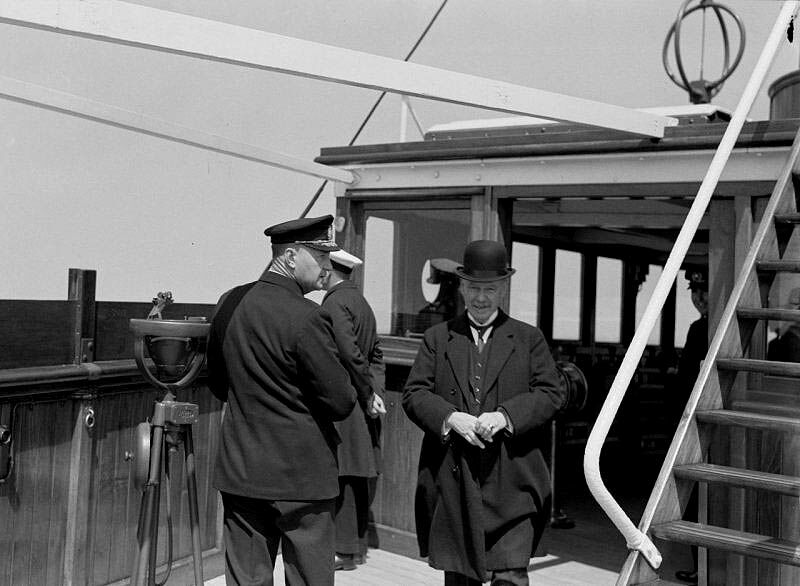
Captain A. Dubois and the Company’s owner Mr. Willem Ruys chat happily
after her speed trial on the port side Bridge wing after her Speed Trial
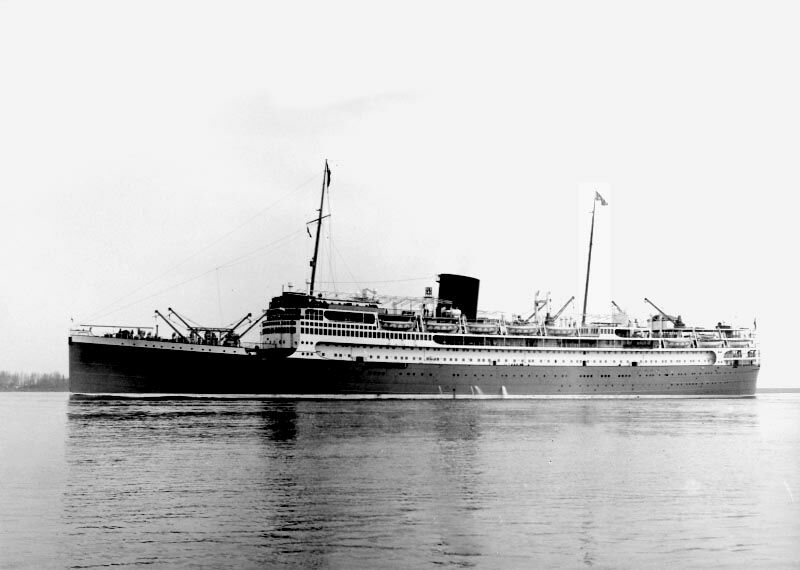
She is seen here on the “Nieuwe Waterweg” retuning to the ship yard after her Sea Trials
At the yard she was given a final paint job making her ready for her owner and passenger services and, some fine tuning of her engines, etc. Thereafter the M.S Baloeran, which had cost at total of 12 Million Dutch Guilders to build, was officially delivered and handed over to the “Rotterdam Lloyd” on April 9, 1930.
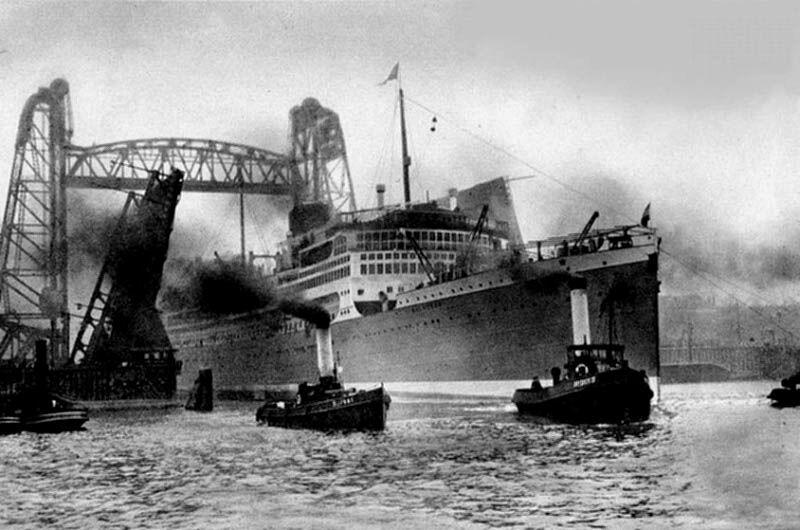
The M.S. Baloeran is
seen being delivered to her owners in
The company made her
ready, by crewing her, and ensuring that the ship
would be perfect on the day her passengers boarded her. For she would be fully
stocked with the finest and freshest foods and an abundance of delicacies as
well as all the drinks one could possibly desire. Her holds were filled with
goods to be taken to the
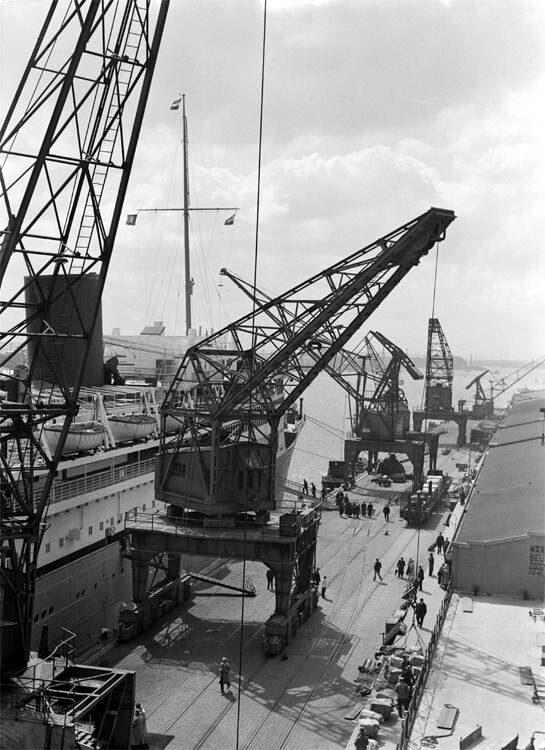
It is the day of her maiden voyage and we see passengers arrive during
the morning at the “Lloyd Kade” - the “Rotterdam Lloyd” Wharf
Her big day was finally at hand and by 1400 hours on April 16, 1930, all of her passengers had checked in and as the afternoon continued she was full of excited passengers, who had brought some family members and, or a few friends on board as each passenger were given a certain number of visitors boarding passes to board the ship. They would be able to check out the cabins and tour the ship, but only the Class their family or friends were booked in, and, then head to one of the lounges and enjoy a drink together, until that time when that dreaded announcement came “All visitors ashore please, all visitors ashore please,” which would be followed soon after by; “This is the final call, all visitors ashore please, our gangways will be removed very soon, please leave the ship now. This is our last call!”
Having said goodbye to their relatives and friends and with them having left the ship, the passengers headed for the decks to wave their loved ones and friends goodbye. As with every departure a band would be playing on the wharf thus getting everyone ashore as well on board it was a very emotional moment.
But then, suddenly came
that dramatic moment, sharp at 1700 hours when the lines had been let go and
the “Baloeran” slowly left the wharf perfectly on time and with
Captain Boon in command he took her out and into the
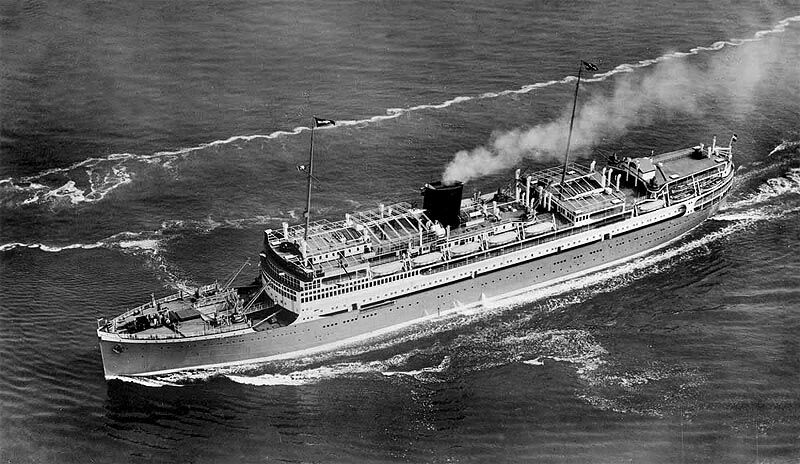
An excellent
aerial photograph of the M.S. Baloeran seen during her maiden voyage
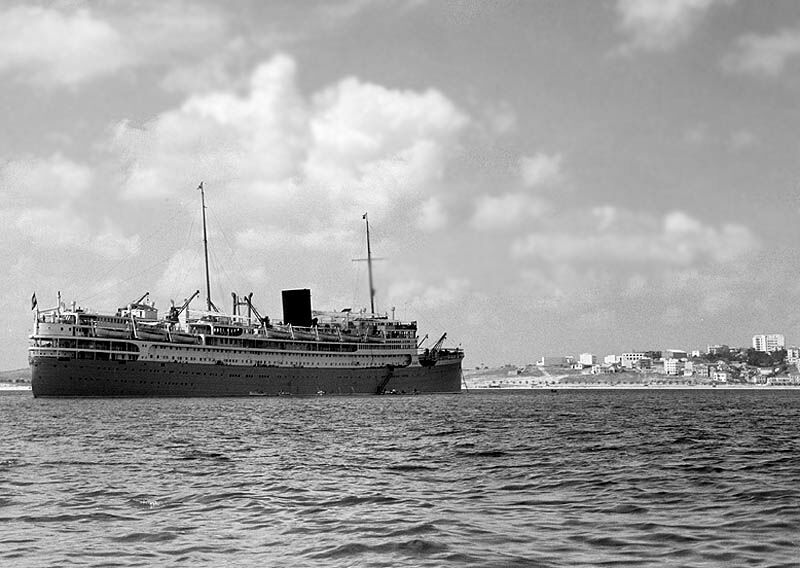
Above &
below: the M.S. Baloeran is seen arriving at
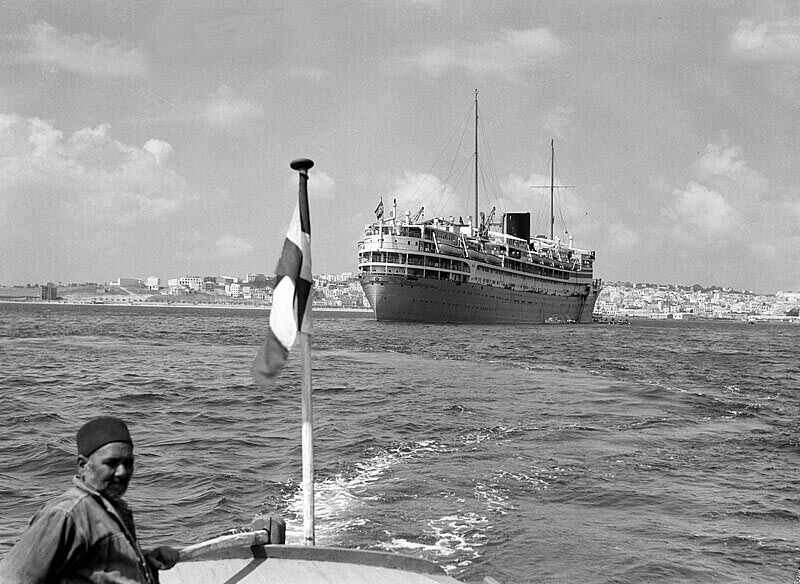
Schedules in the 1930’s were as follows:
1930 to 1937:
1938 to 1939:
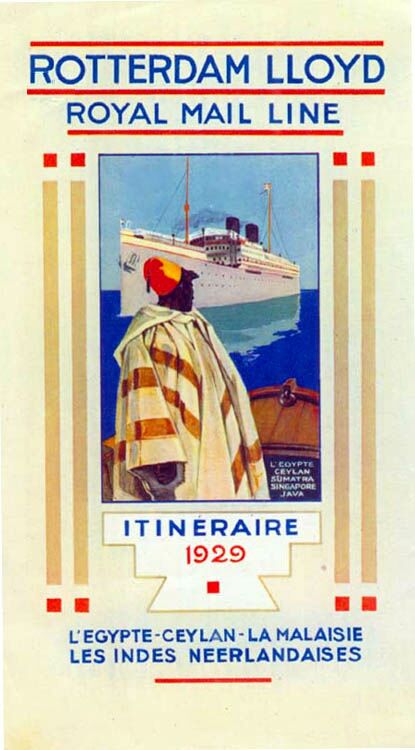
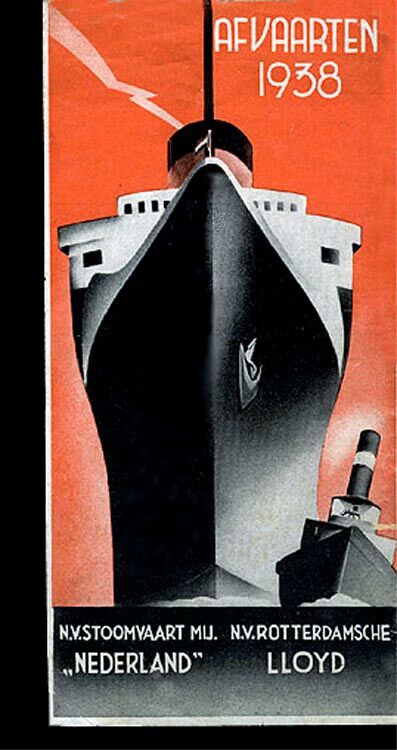
The service shown above 1930 to 1937 came from the schedule above that commenced in 1929, whilst the second service from 1938 to 1939 came from the 1938 schedule.
Her return voyages were generally around 105 in length, being partially due to her cargo loadings at various ports, etc, and she would also take on cars if required.
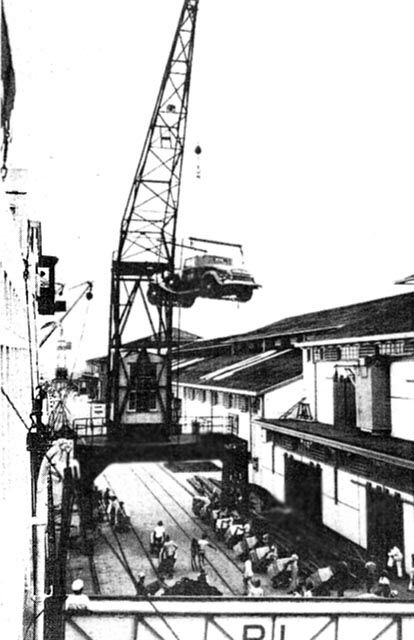
Here see a car
being loaded at
On
her maiden voyage she departed
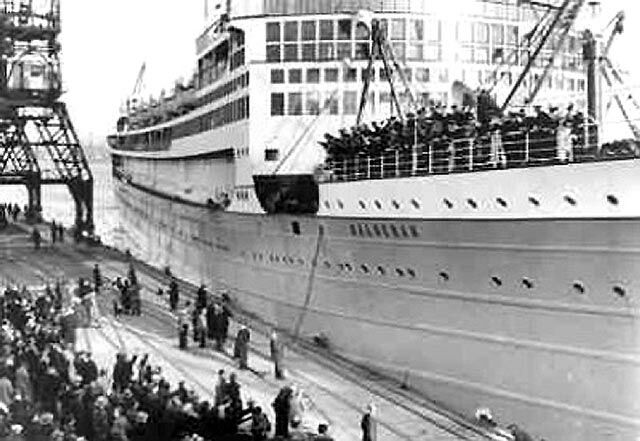
She is seen
arriving at
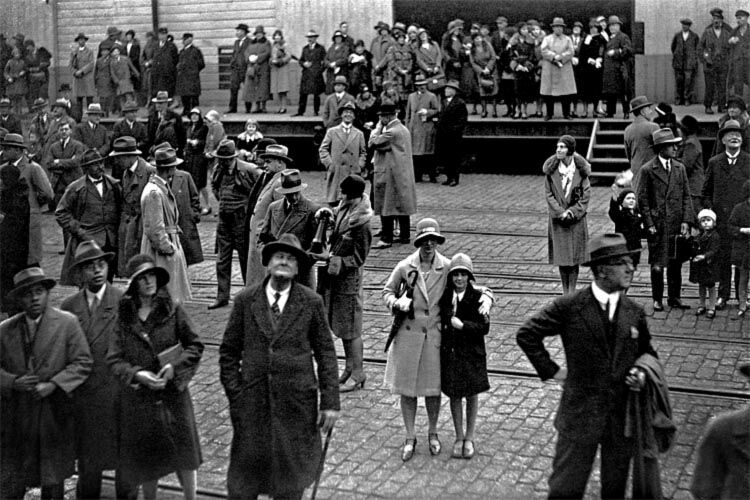
Above & below: Two scenes of her second departure
Family and friends are standing ashore saying goodbye to their loved ones
And the Baloeran is ready to let her lines go
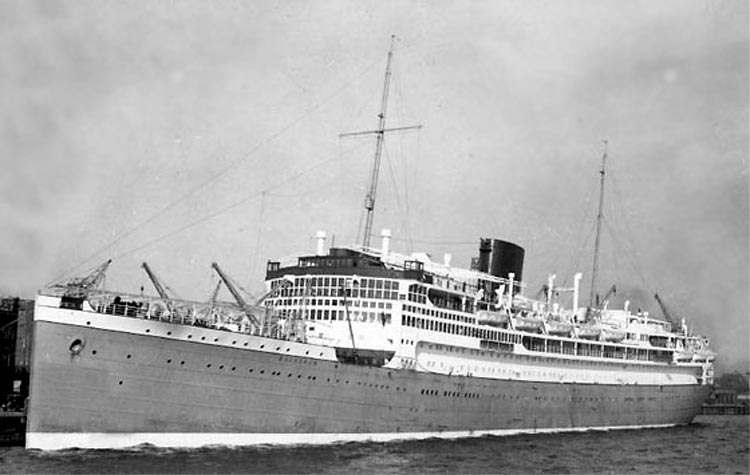
*********************
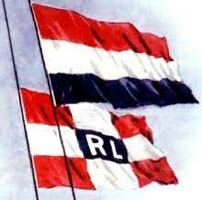
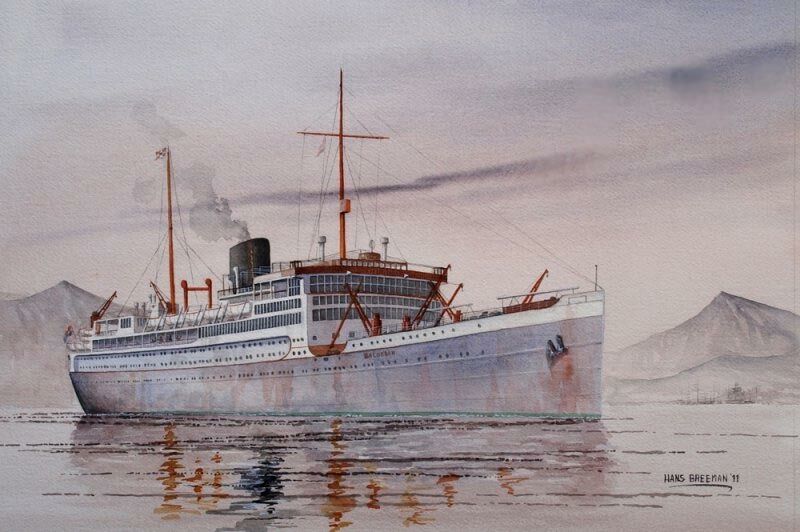
This is a magnificent work of art of the delightful M.S. Baloeran”
It is by a
wonderful Maritime Artist Mr. Hans Breeman
M.S. Baloeran
Interiors & Exteriors:
Reuben Goossens.
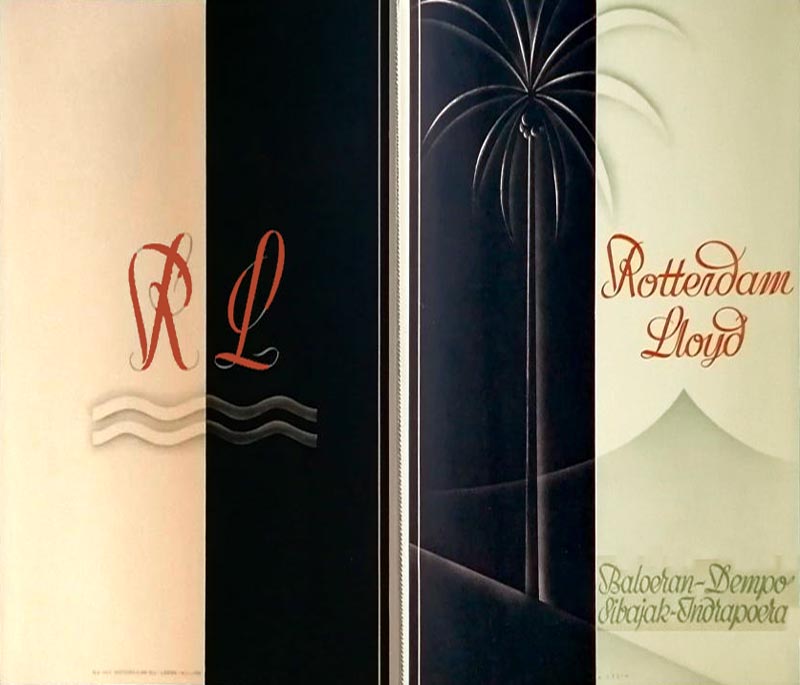
Above &
below:
In 1930 Rotterdam Lloyd published a fine brochure covering four of their ships including the Baloeran
whilst some of the ships were already in service some others were not
completed as yet.
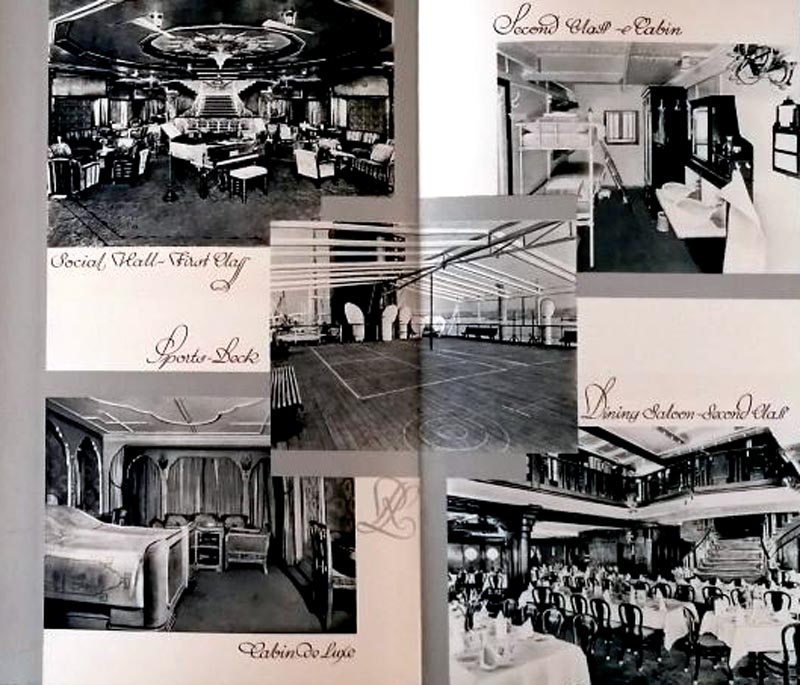
First Class is seen on the left & Second Class on the right
This is just an
introduction of what follows below for she was certainly a classy ship indeed!
First Class:
Above the Bridge is the ships Fore Mast, with the ships horn, a bell and of course the Crow’s nest, being the traditional Lookout.
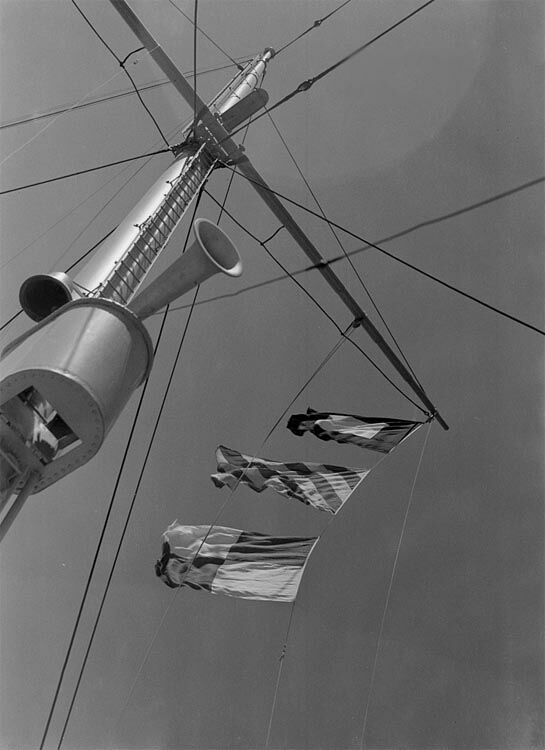
The Bridge, etc:
Far forward there is the Bridge and Chart Room as well as the Captains Quarters and a private deck space on both sides.
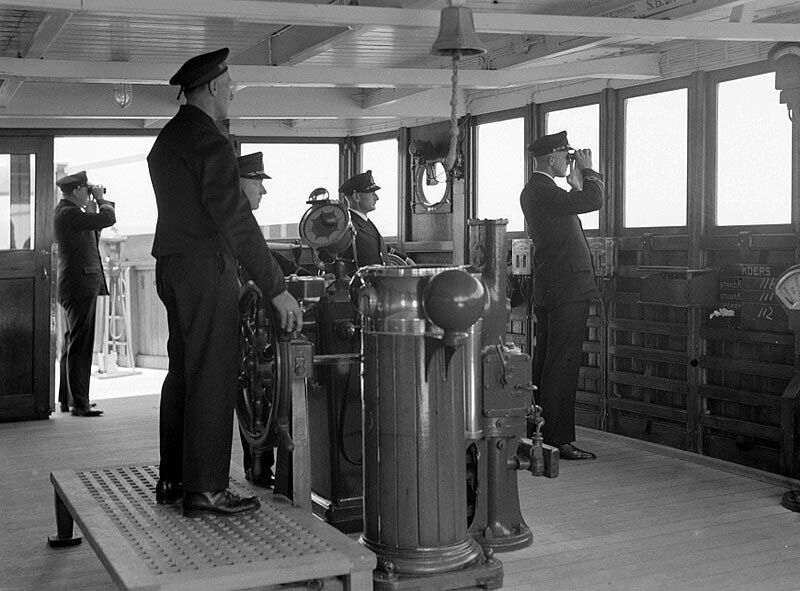
A busy Bridge
always keeps the ship on its course
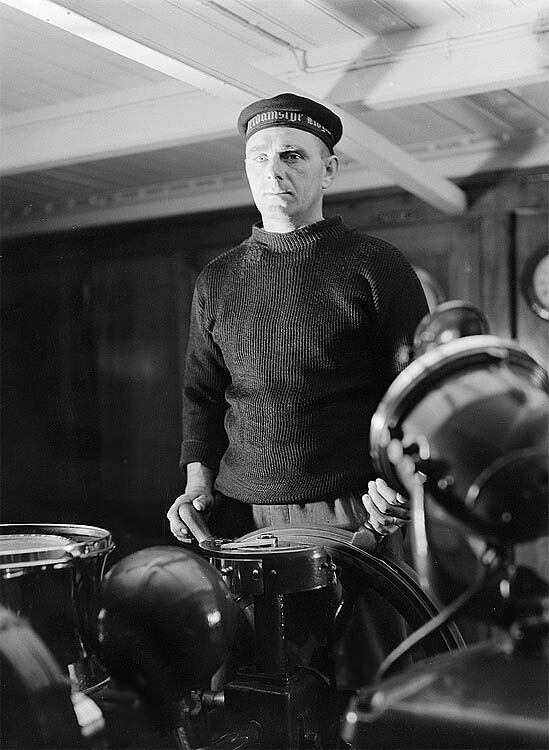
The helmsman or
Quartermaster is seen at the helm
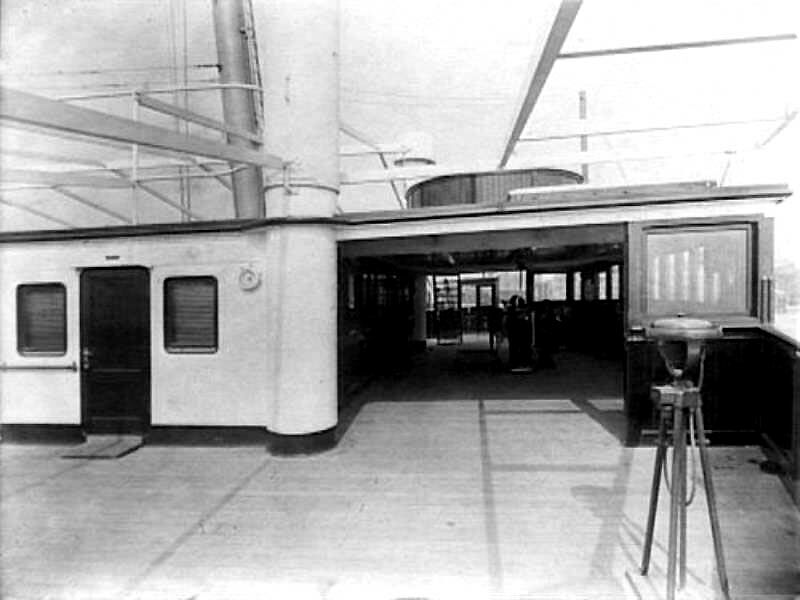
This is the starboard side wing of the bridge and we see the Captains door to his quarters
and a private deck space available only to the Captain and his officers and their guests
Sports Deck:
Aft is a spacious Sports Deck for the First Class Passengers with nets to play Tennis, or Deck Quoits and Shuffle Board, etc.
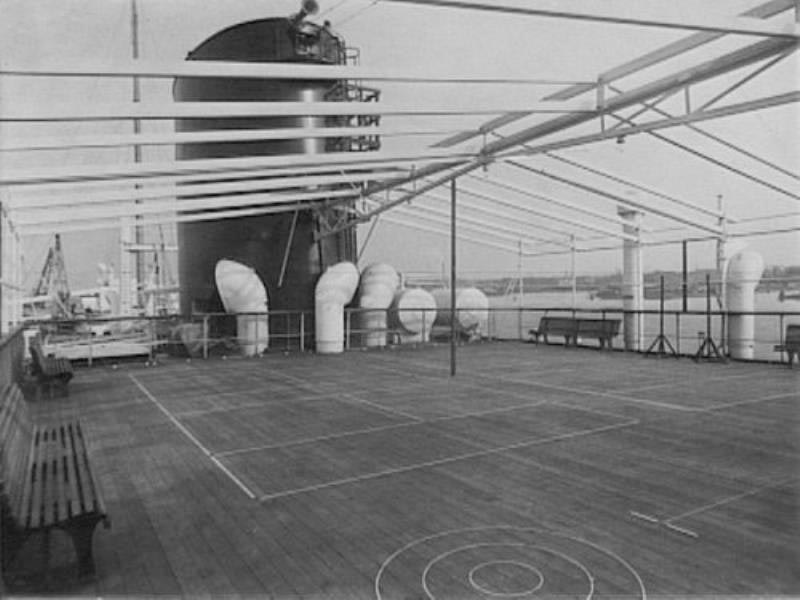
As can be seen,
this area can either be open or covered, pending the weather.
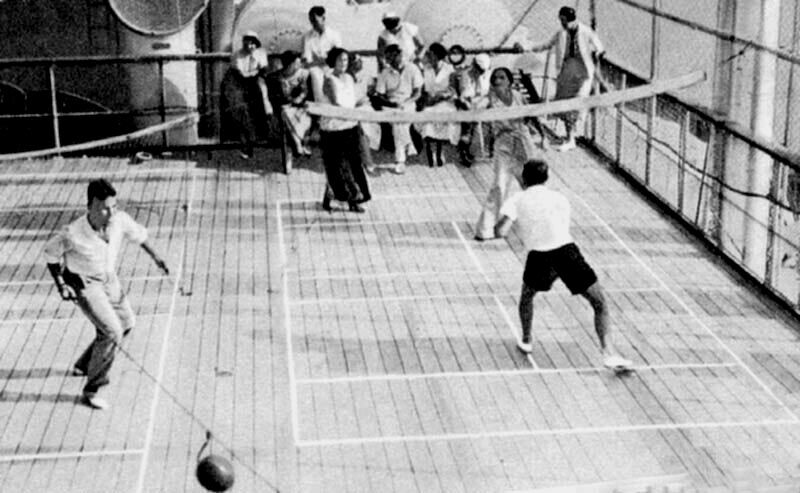
The couple on the right are playing Deck Quoits, but the man on his own,
well I have no idea what the game he is playing with that ball?
However on certain occasions, be it on a nice day or an evening a dance party may be organised, be it for a private occasion or one for passengers in general to enjoy with recorded music.
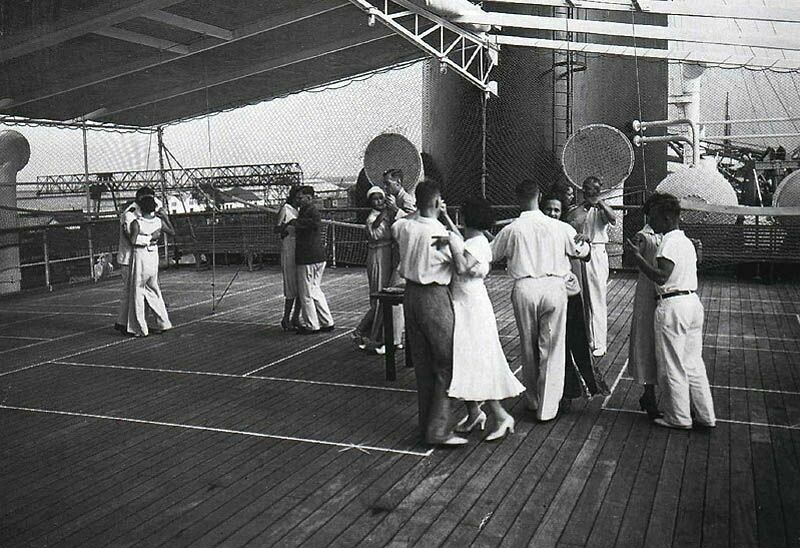
Dancing up on Sport Deck
Boat (A) Deck:
You may arrive on this deck either via the magnificent First Class Main Stairwell or via one of the two elevators (lifts). Between the lifts you will also find a separate single stairway that goes up to the Deck I have mentioned above.
Forward Promenade & Entertainment Area:
Far forward is a huge deck space, which is under cover, and has windows across the front and just four windows along both sides. Thus this space is open sided and it had various uses, including being the perfect daytime location to relax, or for large parties, dancing, and games such as horse races and other fun games etc.
The ship Orchestra would play here during dances and parties, or in the Social Hall, come Music Salon on Promenade Deck and they had a huge repertoire of well known-tunes and suitable melodies.
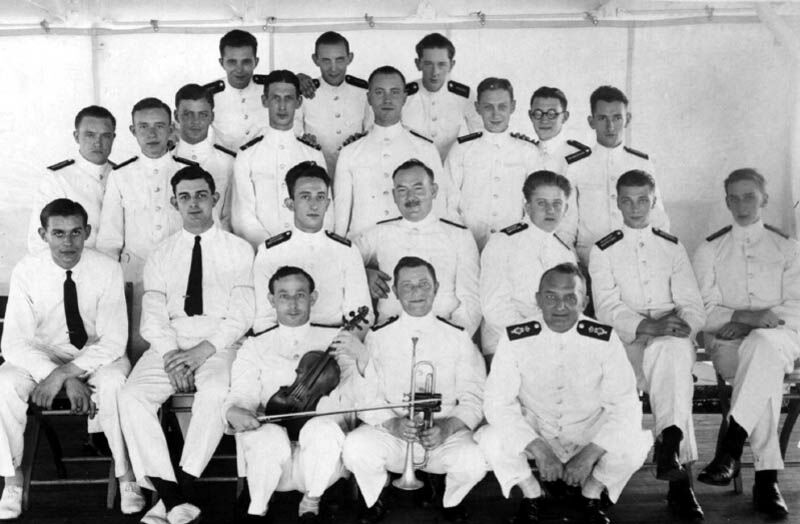
The “Baloeran” Ship’s Orchestra
Just aft of the Lobby is a Service Bar, and on both sides aft are the male and female facilities for the Gents and the Ladies for those who may be on this or the Sport Deck.
Radio Room:
On the portside aft is the Radio-Telegraph Station, with a waiting room as well as a phone box. The “Baloeran” was also one of a number of ships that were used by ‘Marconi’ for his experimental broadcasts and thus it was fully equipped with his instrumentation and transmitter. Here also is the Ships music station that provided music throughout the ship.
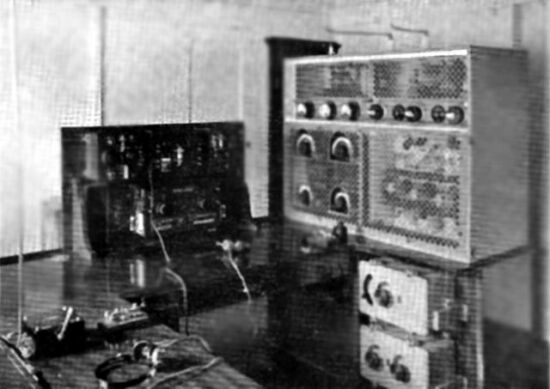
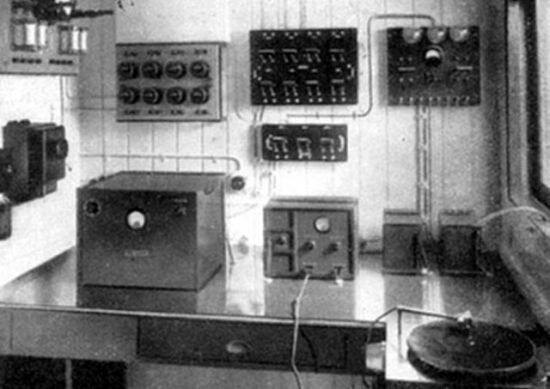
The Marconi station & its transmitter and the music station on the right
On the starboard side aft is the Photographer’s room.
Promenade (B) Deck:
The Social Hall:
The grandiose Main Stairwell was without a doubt a major feature of grand circular Grand Social Hall, which was such a beautifully designed venue, and was covered in the finest mahogany timbers and furnishings that could be found! Everything in this grandiose venue was created to impress, the light fittings, the statues, the walls, the carpets, the furnishings it was simply the ultimate in luxury, it was simply Palatial!
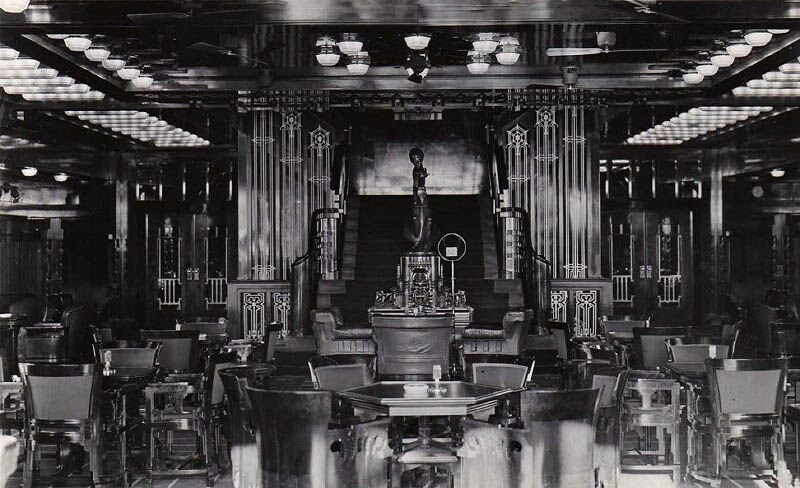
The Social Hall
looking aft to starboard and that magnificent Main Stairwell
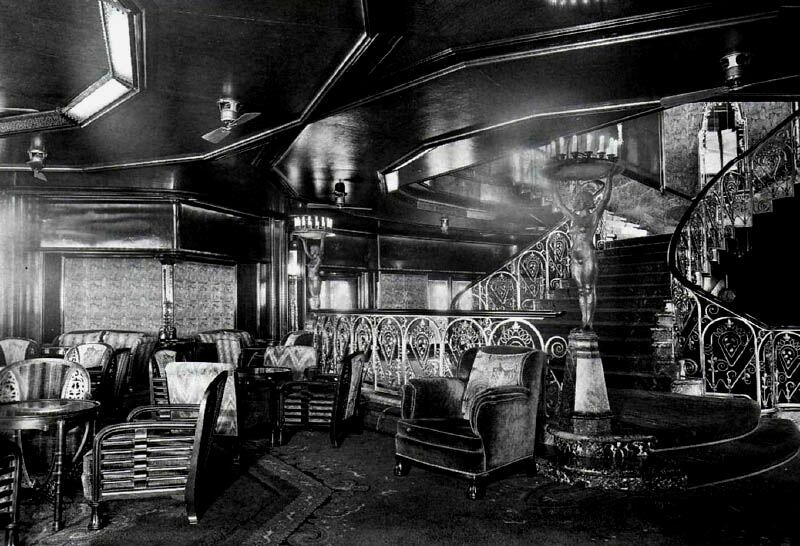
On this Stairwell
the ladies could really make a grand entrance in their splendid evening gowns!
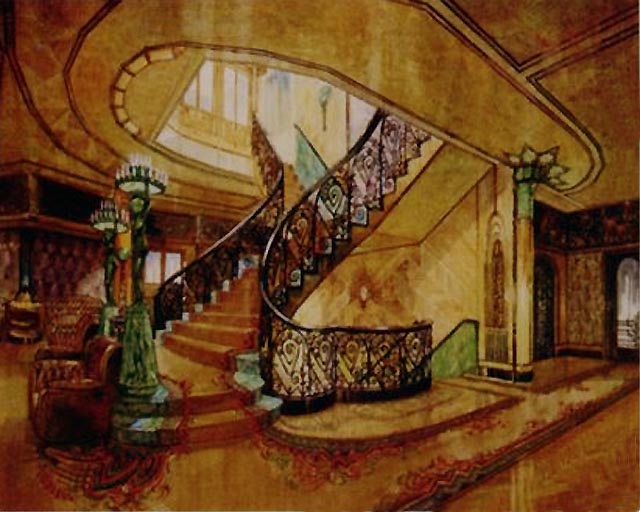
An artist’s
impression of the Grand Stairwell
The artist
is the wonderful Mr. J.H. Sikemeier
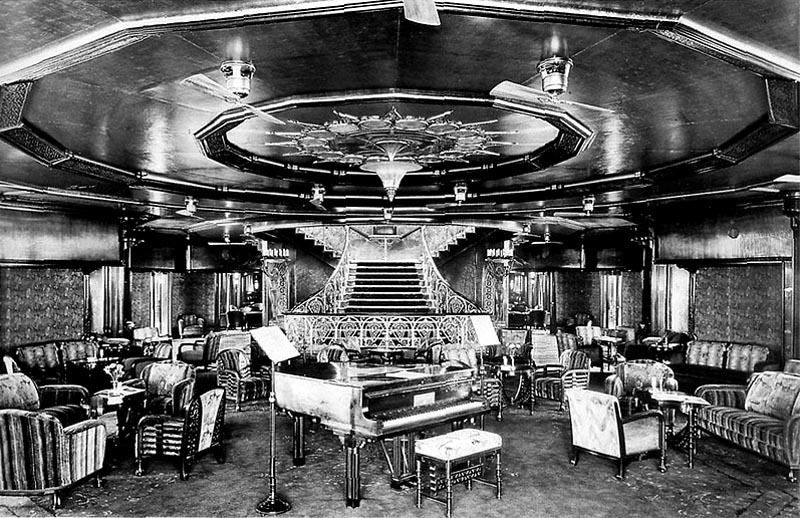
And of course this was also the Music Venue
The Smoke Room and Bar:
As we head just behind the Grand Stairwell you would arrive directly in the Smoke Salon, which like the Social Hall was in a dark walnut and again featured so much detail, such as carvings, fine carpets, the finest and most comfortable lounge chairs and sofas, and every single details came from an artist extraordinaire, who was world famous, and created some of the world’s greatest hotel interiors, which were fit for Royalty!
The Smoke Room was unlike the circular lounge that it joined, for it was completely square. On the aft wall centred was the Bar, which served both venues of course and it was a popular place to be at.
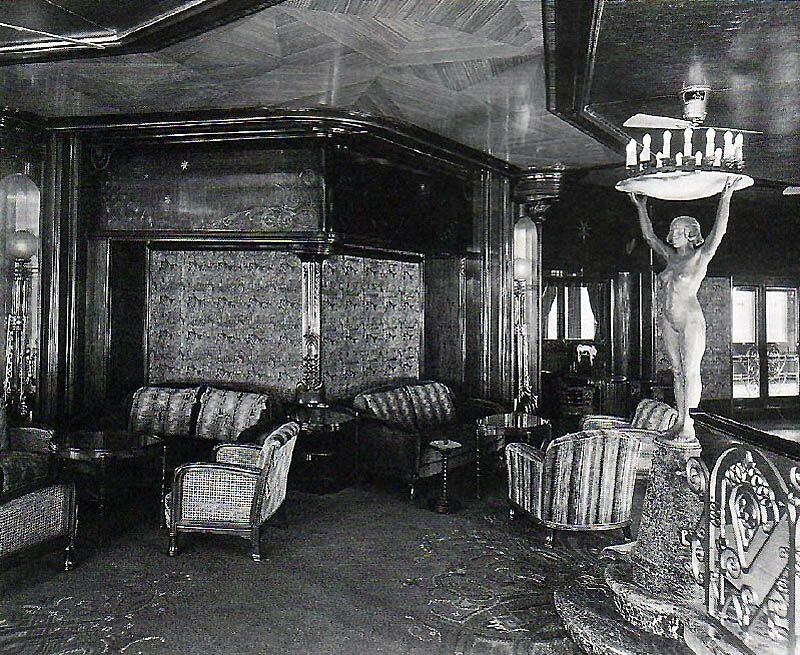
The Starboard side
entry to the Smoke Salon
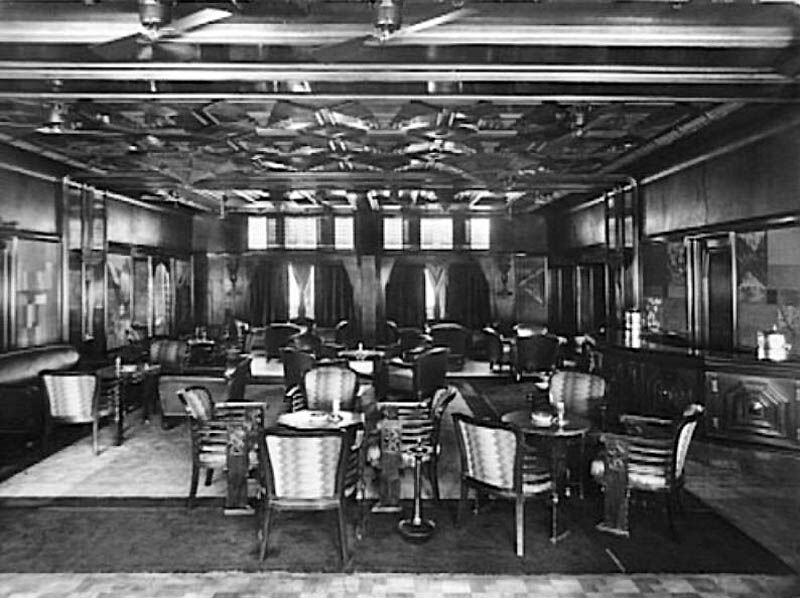
The Overall venue
and the Bar which was on the aft wall - looking to starboard
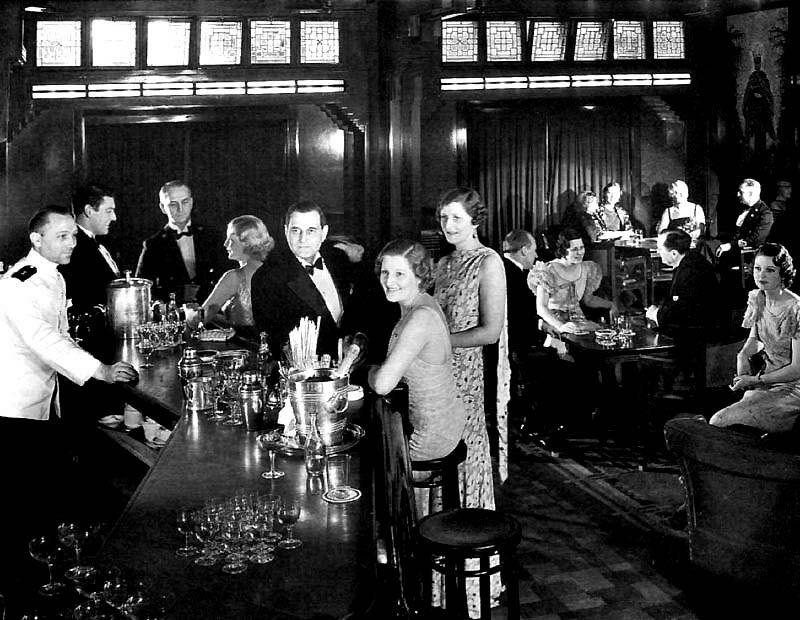
The Bar –
now looking to port of course
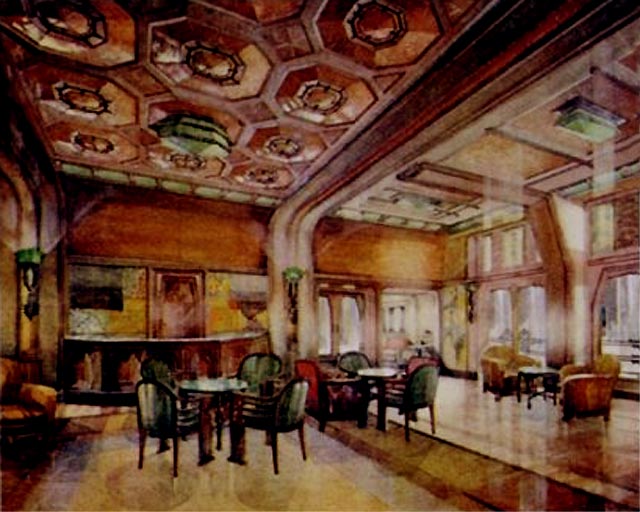
An artist’s impression of the Smoke Room
The artist is the wonderful Mr. J.H. Sikemeier
Outside, there was a wide and spacious but a partial walk-around Promenade Deck at the forward section, with almost 97% the length of the lounge area of the deck being glazed in. The open-sided deck ended just aft of amidships, as it was taken up by the First Class Children’s Play-deck, and directly aft of that was the Second Class Lounges and deck space, which will be covered in its own section.
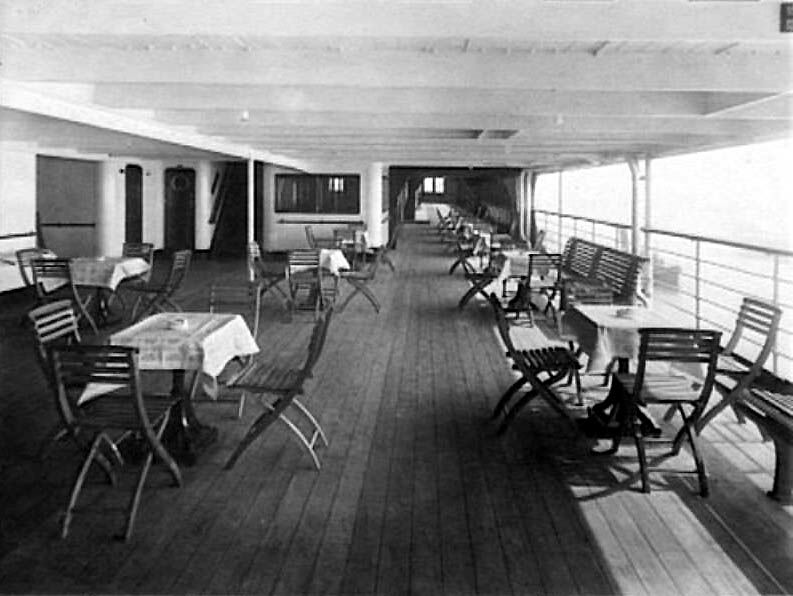
A spacious Promenade Deck seen on the starboard side and looking forward
Although the ships housing ended at the rear of the smoke room, thus the walk around would go around there and right to the front of the ship, etc.
Accommodations:
But then the next section contained accommodations, there were two spacious twin bedded cabins forward Cabin 2 portside and cabin 1 starboard. These were followed by five single bed cabins also on each side. As always even numbered cabins are on the portside and odd number cabin are starboard. Cabins 4/6/8 & 10/12 had connection doors, and 3/5/7 & 9/11 also had connecting doors, thus these could be booked in any way as desired.
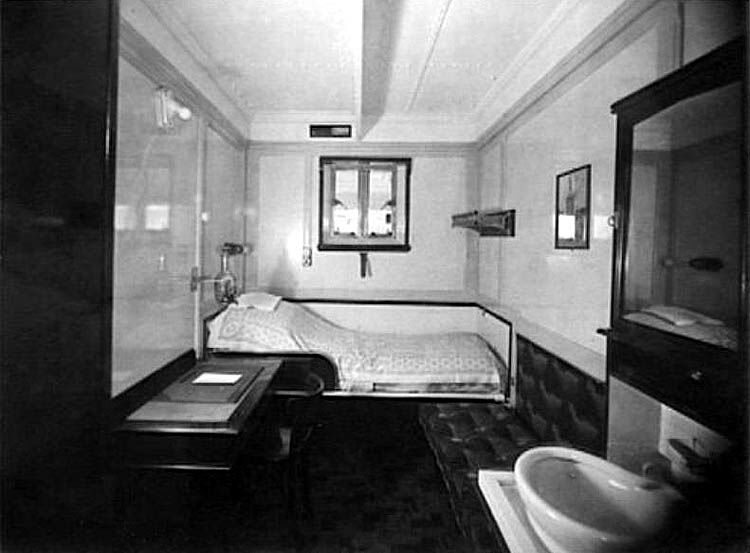
A single bed cabin with a sofa
Of course single every cabin on the “Baloeran” regardless of class was located on the outside and had a window or a porthole that could be opened for fresh air.
Hallway:
Aft of the twelve cabins was the hallway for that section and there were doors in order to go out to the Promenade Deck and along the aft wall were stairs crossways to go down to C and D Decks.
Children’s Playroom:
Directly aft was the Children’s Playroom and the own separate deck space. The playroom was fully equipped with every possible facility to keep the children fully entertained, there was even a Punch and Judy style of show installed.
There were both fully trained female playroom nurses and male stewards at hand to guide the children in their games, as well as provide them with snacks at the right times of the day. However, they would also have their meals here as the long tables would be set up for meals at the appropriate times, and their parents would be invited to attend to assist if they desired to do so, but the children’s nurses and stewards were experts.
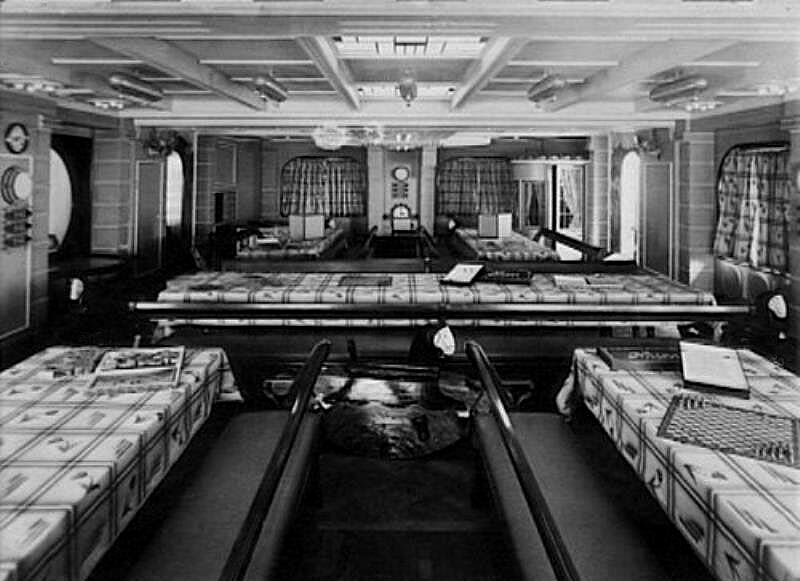
Above &
below: The playroom looking to starboard and their
safe screened decks space aft
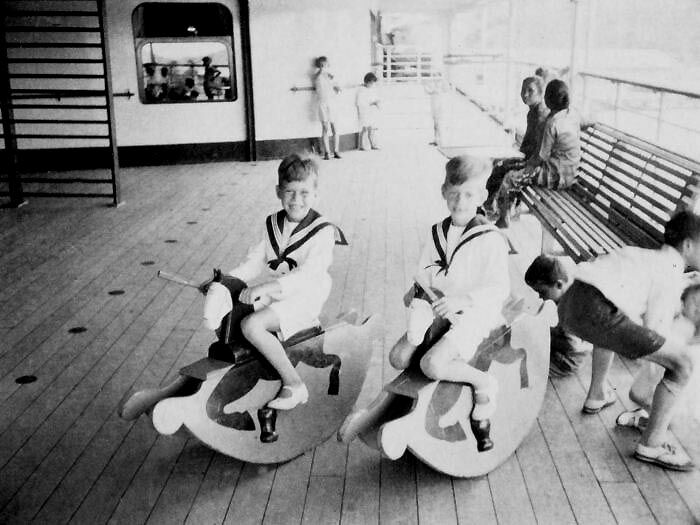
Just for interest, the ships doctor and his surgery and hospital was located in the stern section of this deck, it was a fully equipped facility!
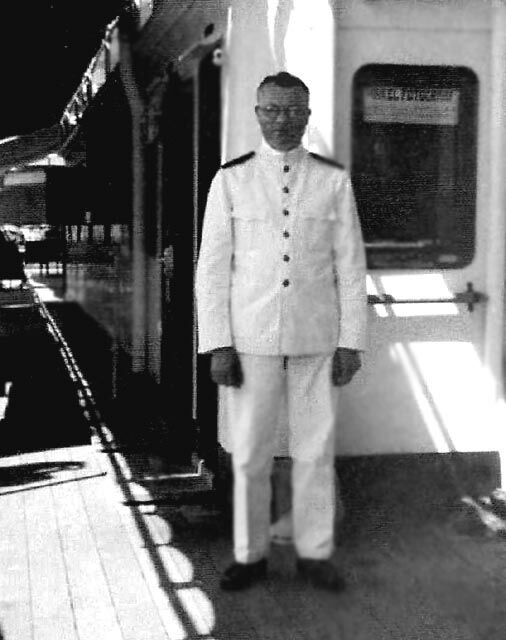
This is the only man on the ship, who never wants to see you, except socially. For this is the ships doctor
Upper (C) Deck:
The first Class part of this deck is entirely occupied with cabins and two Deluxe Suites, which are located forward one on each side. These are spacious suites that have a lounge area, bedroom, and a huge bathroom with a tub, and a personal baggage room etc.
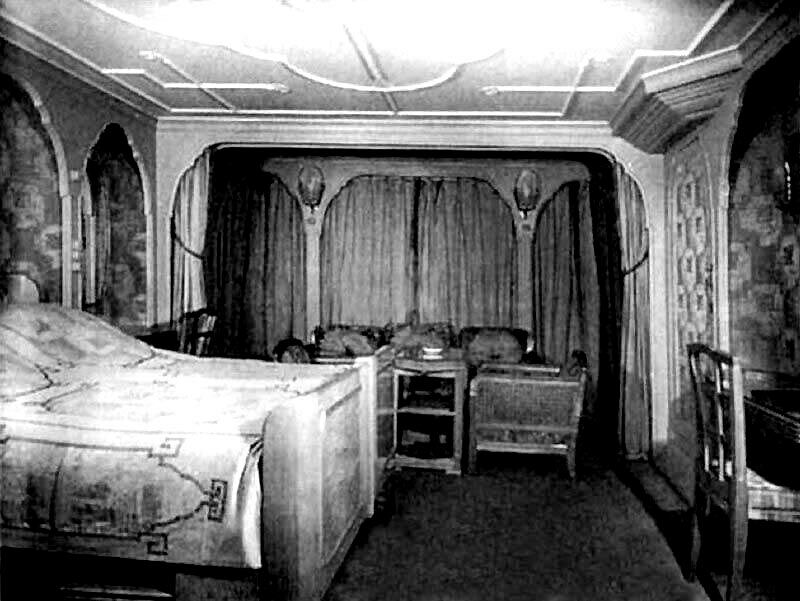
Between these in the middle there were two twin bedded cabins with windows facing forward over looking the ships Swimming Pool, which was located there. These cabins had their private bathrooms, with a bath, WC and the wash basin. Cabins aft were either singles, or twin bedded with some having a bathroom between two cabins and they would share the same bathroom, and lock the door to next door when in use.
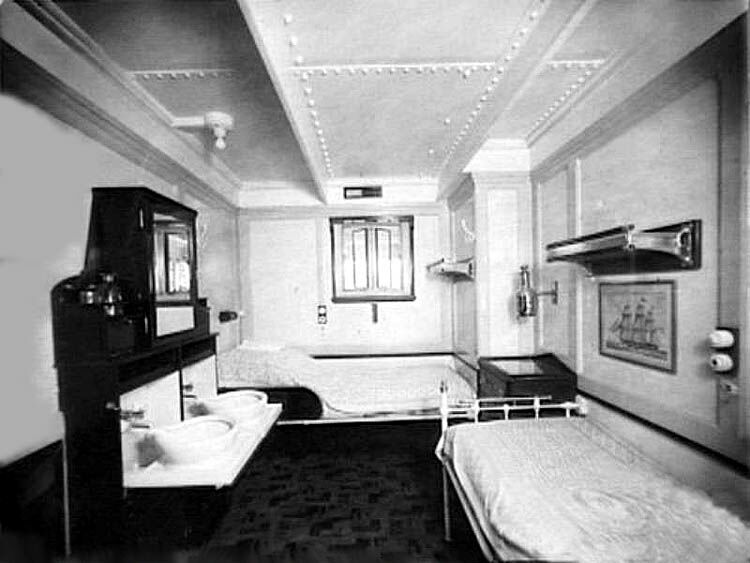
A typical twin bedded cabin with share facilities
Between the amidships cabins 78 and 79 there was a sideways stairwell that went from Deck D to B, and we see it along the starboard side looking forward hallway.
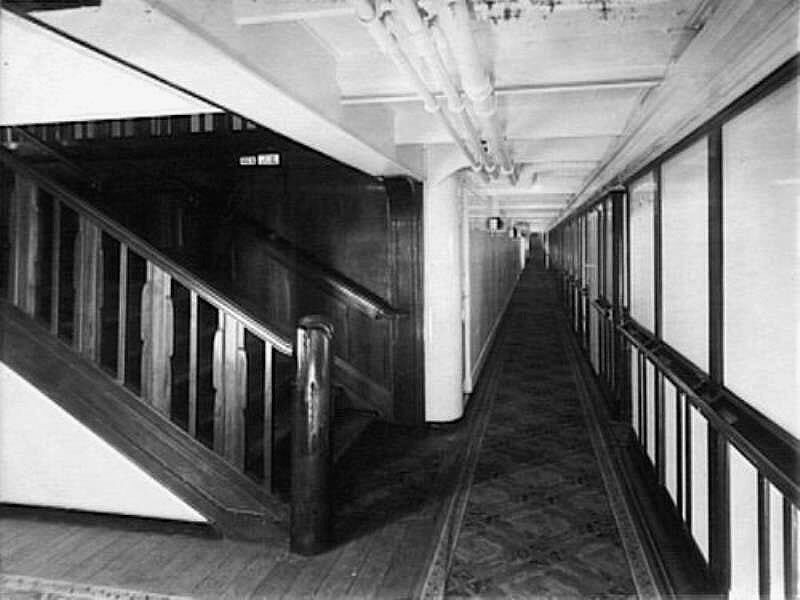
Swimming Pool:
Back to far forward, on the portside the door would open to a bridge that led to the Swimming Pool, obviously a popular place to be in warmer climes, as she would spend a great deal of time in the tropics!
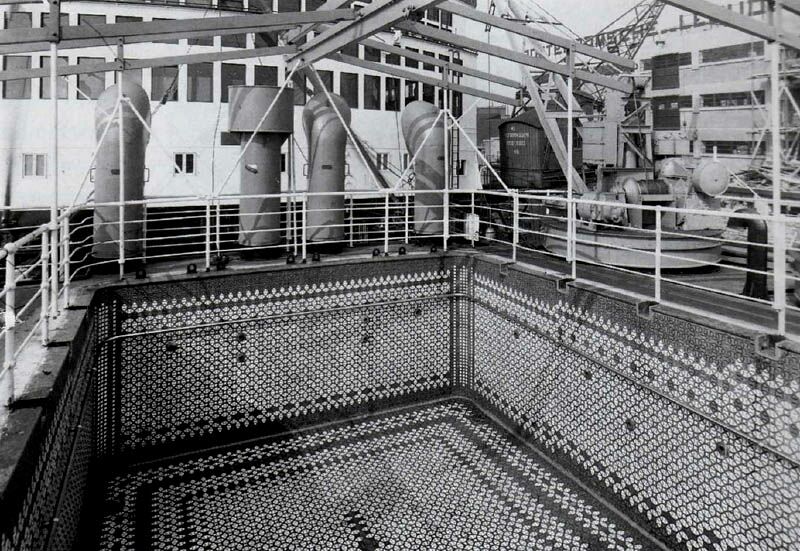
Above &
below: Two views of the ships Swimming Pool
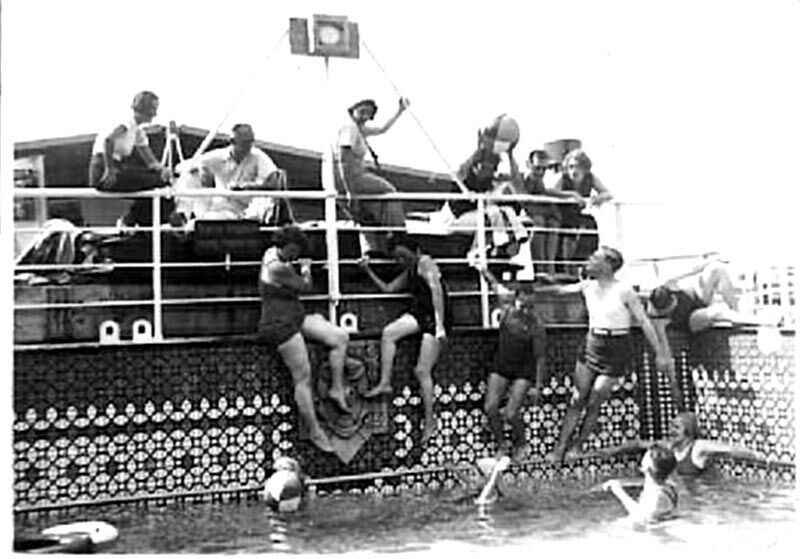
Stairwell & Dining Room Dome:
From fore to aft of the First Class section were all the public facilities, but I should make a special mention of the forward main stairwell and the lifts, as there is something I have not as yet mentioned. Usually on most ships you tend to enter the lifts from the front, but as the Grand Stairwell takes up so much space, with these lifts you enter from the starboard or portside. Also just forward of the Stairs is a magnificent metalwork balustrade of the multiple level dome above the Dining Room down on E Deck. And also the amazing lighting on the ceiling on this deck was simply beautiful!
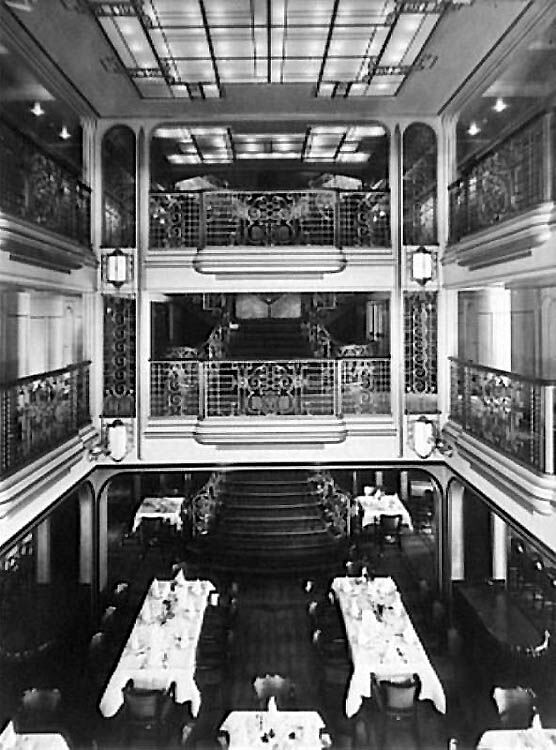
An overall view of the Dining Room
Shelter (D) Deck:
Lobby Lounge & Pursers Office:
Obviously the Dining Room Dome is located forward, but directly ahead of that is a Lounge area, as well as a Band Stand where a part of the Orchestra plays during evening meal times. Whilst far forward on the starboard side is the Pursers Office, certainly being an unusual location for the office to be, as on most ships it is located in a more central location. The lounge is furnished with black wicker furniture.
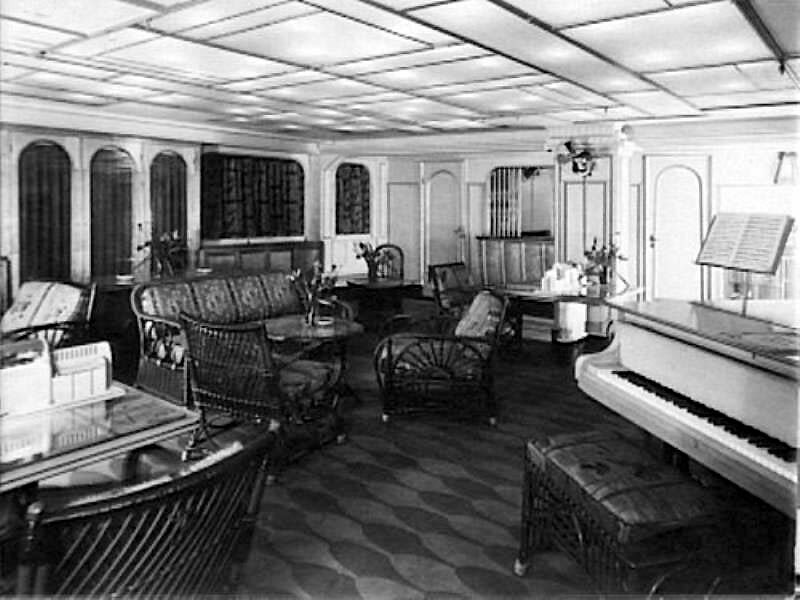
The Lobby at the Main Stairwell is also the First Class Main Entry Hall.
Cabins on this deck are once again singles or twin bedded, and some had the same share style bathrooms as on C Deck. Aft on the starboard side was the ladies Hair Dresser, and the Men’s Barber Shop!
E Deck:
Dining Room:
The spectacular Dining Room spans three decks, with the two decks above featuring highly specialised and especially created metal decorative balustrades topped with luxurious timber handrails, the ceiling up on Upper (C) Deck was huge and simply beautiful adding to ambience. Chairs in the Dining Room are in Walnut and has delicate silk brocade upholstery, and the rest of all timber work follows the trend.
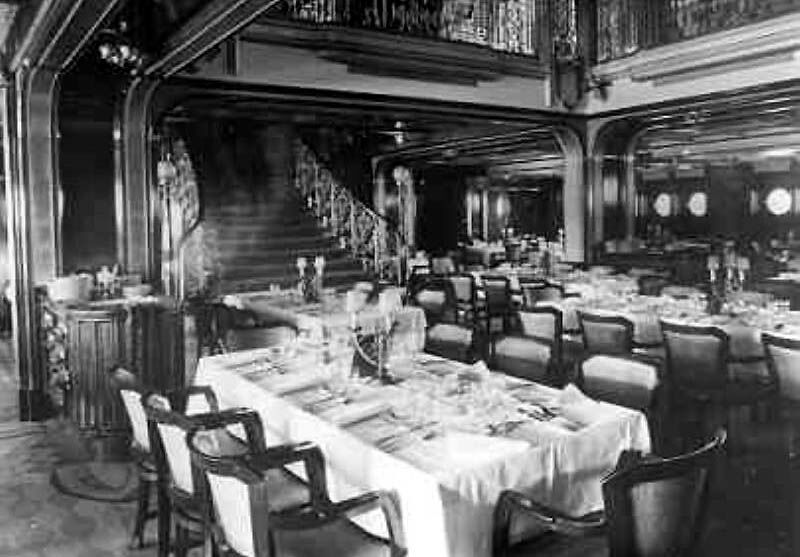
The venue of course receives its grandeur from the Grand Stairwell, and this venue is to say the least very stunning in every respect, especially when you take in the height as well as the beauty of the décor of this beautifully designed Dining Room.
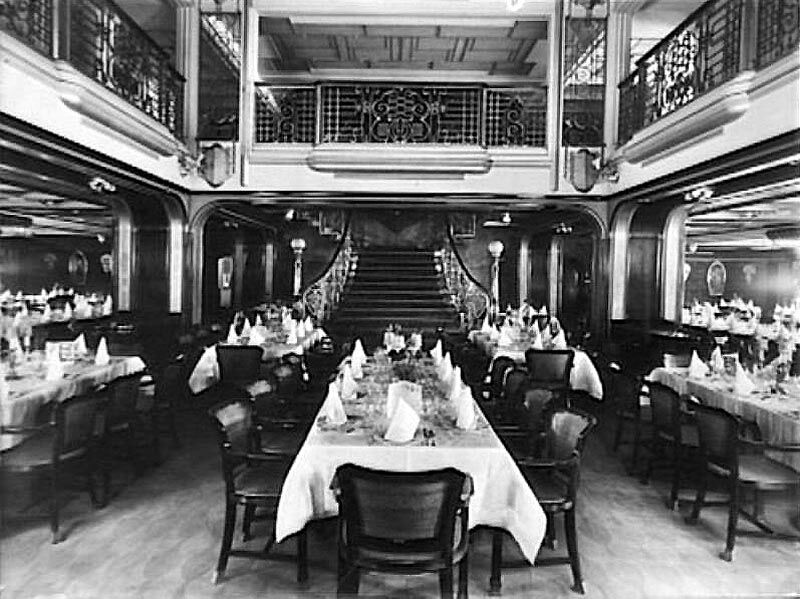
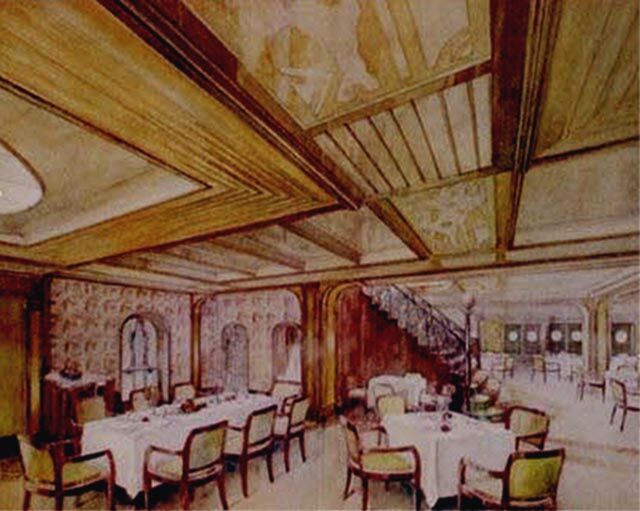
We are looking aft and this is the alcove to the starboard side and this artwork
shows table No 25, for 8 and table No 31 being for 4 guests
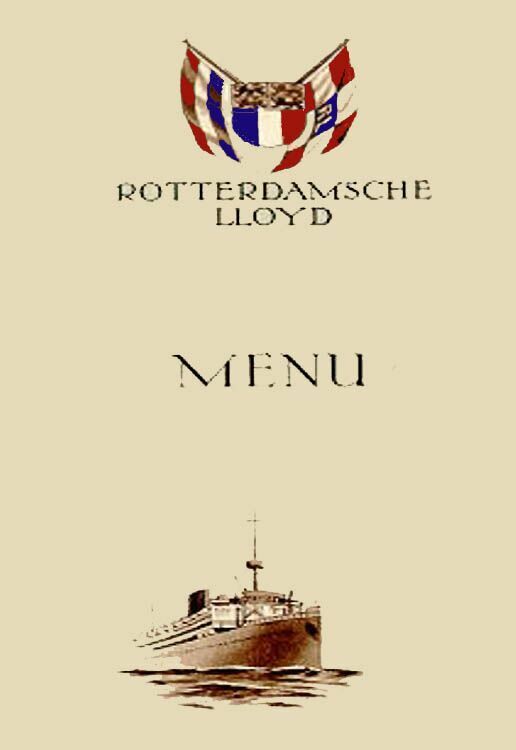
Above &
below: A Menu cover and the Menu for Thursday March
16, 1932
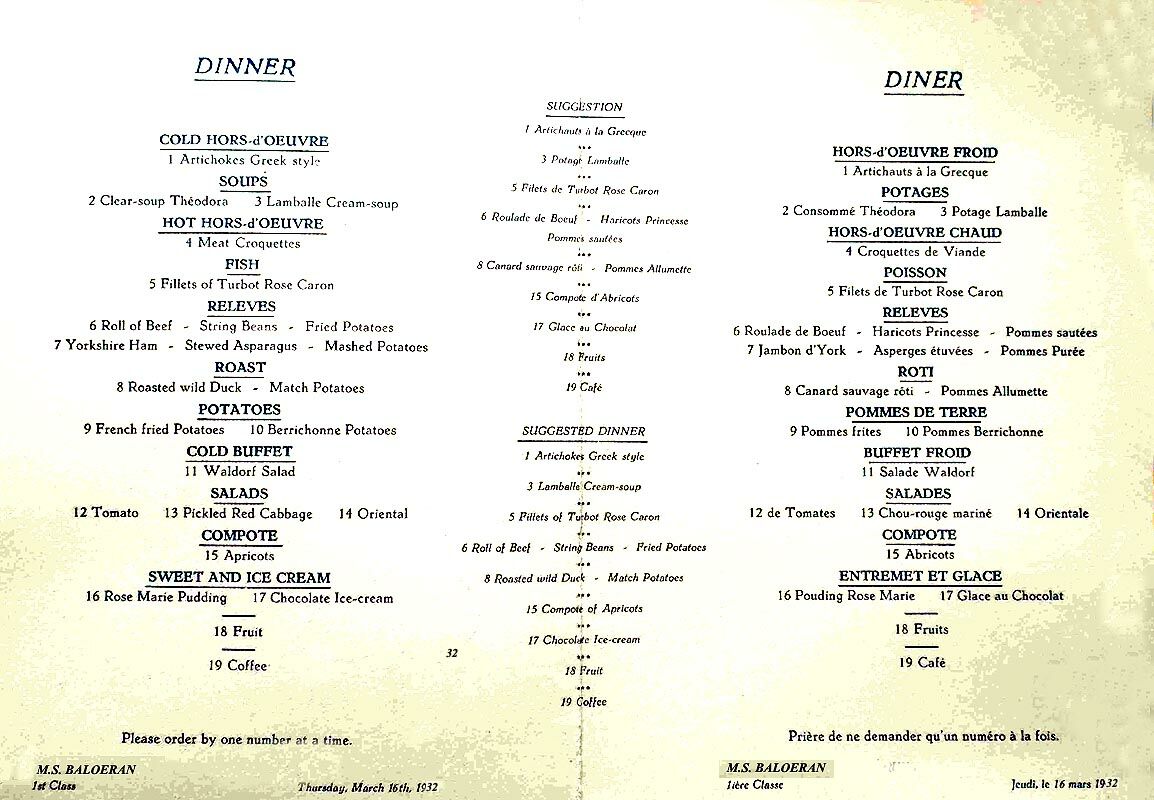
*********************
A Note regarding the Indonesian Crew:
Rotterdam Lloyd certainly had the most wonderful Indonesian crew and their stewards were simply outstanding. In the photograph they are seen having lunch aft of the ship on the “poop deck”.
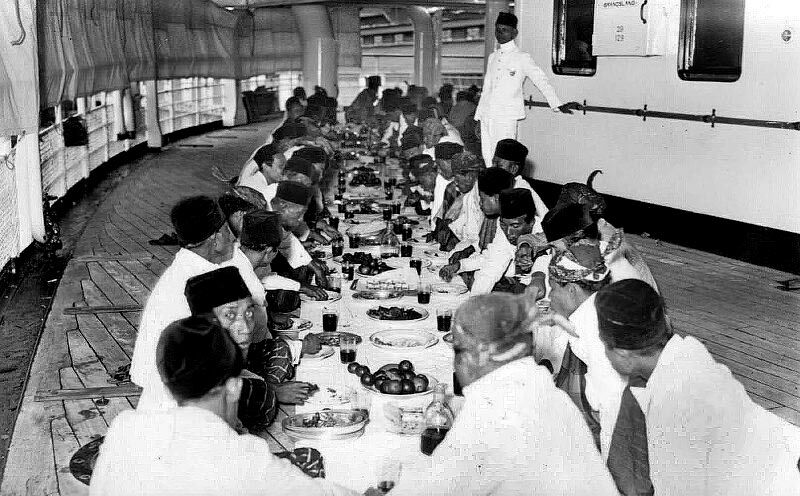
The company certainly looked after their amazing super efficient and friendly Indonesian crew extremely well, as I personally witnessed when I sailed on the delightful then named “Royal Rotterdam Lloyd’s” 1928 completed liner M.S. Sibajak from Rotterdam to Wellington, New Zealand in 1958, and these wonderful stewards could not do enough for you to make your voyage an absolutely happy one as well as ensuring that everything is perfect! And believe me for me they were a vital part of my life, as you will discover when you read my story on my 11 page feature of the “Sibajak”, which was such a fine ship and it changed my life completely!
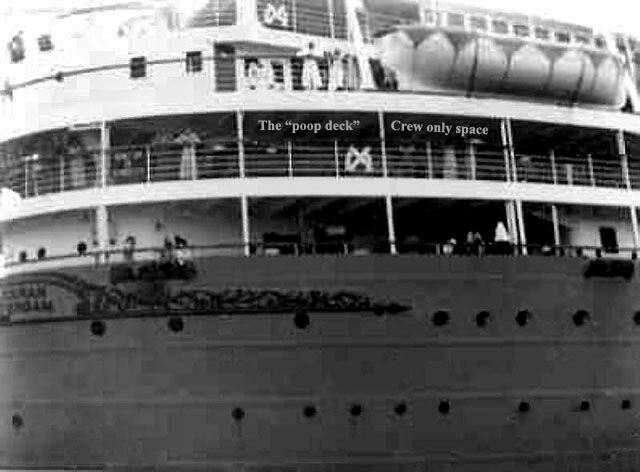
*********************
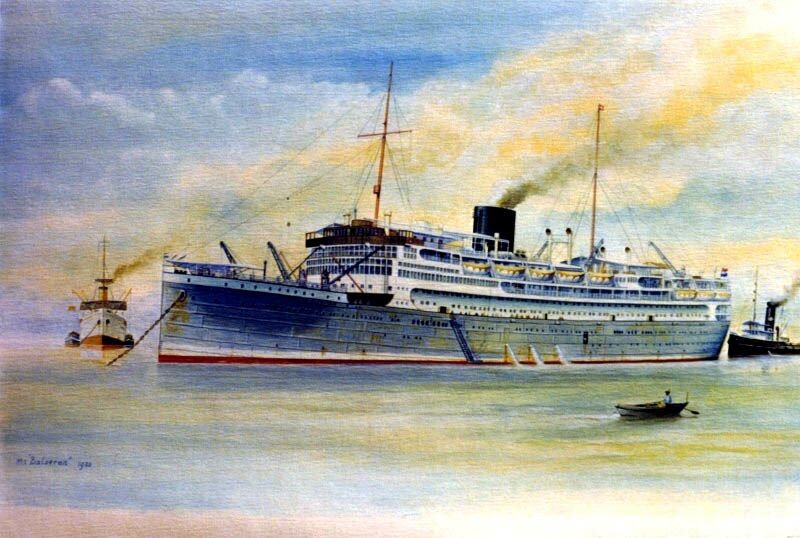
A beautiful watercolour of the delightful M.S. Baloeran
Second Class:
Boat (A) Deck:
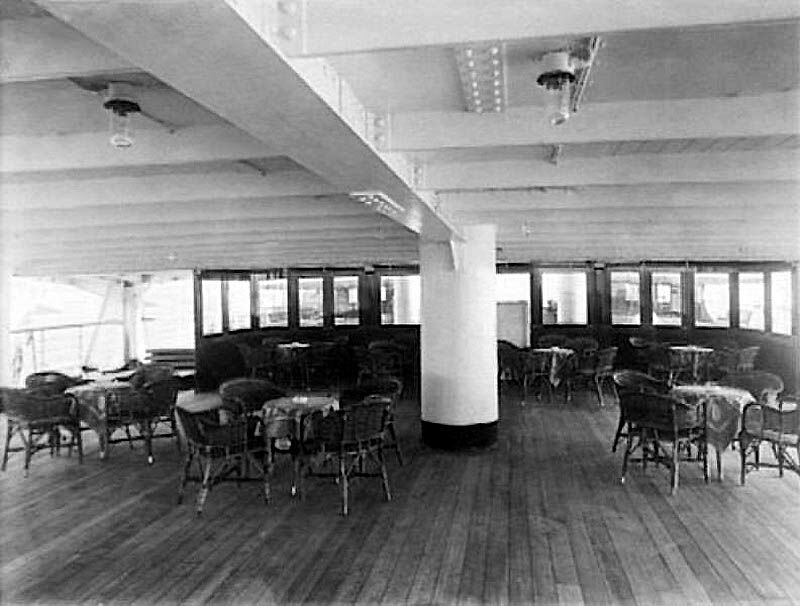
Promenade (B) Deck:
Smoke Salon:
The Smoke Salon is something to be believed for Second Class, for it is quite some venue, unlike the First Class one, no it is not just a single level venue. This one is a two level venue and it is magnificent. OK let me show you!
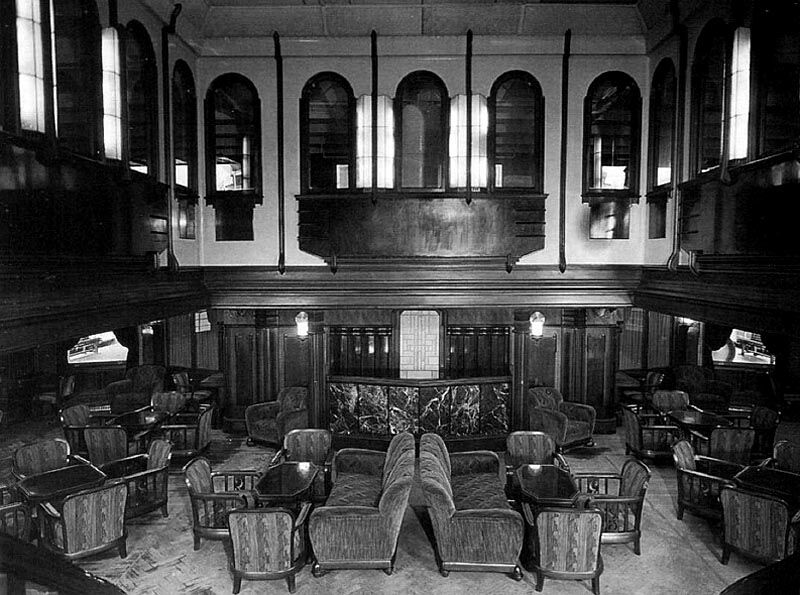
Above & below: 3 views of the Smoke Salon Looking forward towards the Bar
And the other aft
toward the Stairwell
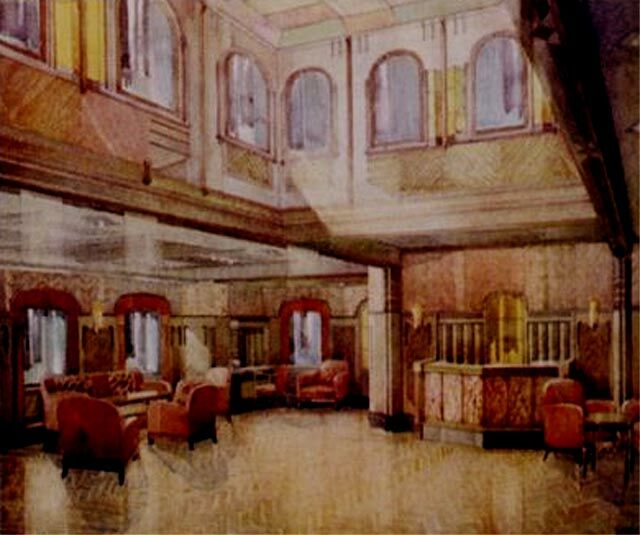
The artist
is the wonderful Mr. J.H. Sikemeier
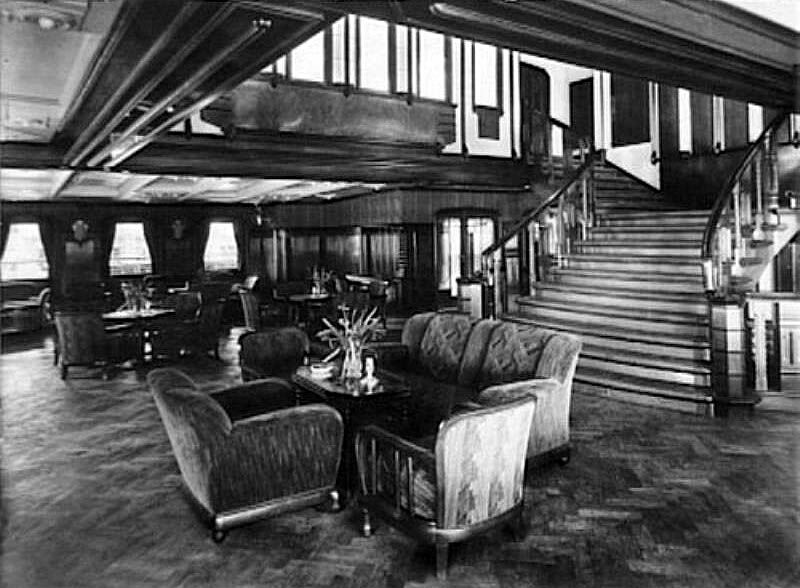
This beautiful Lounge is superbly furnishes with deep comfortable sofas and armchairs with walnut tables, and the walls are all in dark luxuriant woods, the Bar is fronted with dark marble, yet the floors are of lighter shade of timber parquet.
Social Hall & Music Salon:
The Social Hall, come Music Salon was a most tasteful and a more delicate venue, again featuring walnut timbers along all the walls, with feature marble panels, ivory ceilings with decorative panelling and especially created lighting as well as wall lamps. Here are superbly inlaid timber floors, which provide a perfect contrast to the dark walls and the cross sections along the ceiling and the pillars. The furnishings are elegant tables with fine arm timber chairs beautifully covered with fine silk coverings
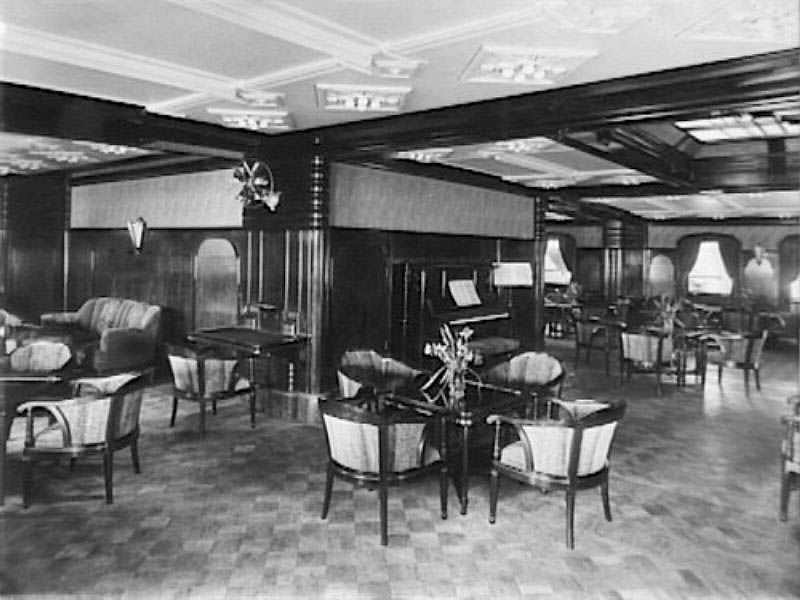
Above &
below: 2 views of the Social Hall - Music Salon
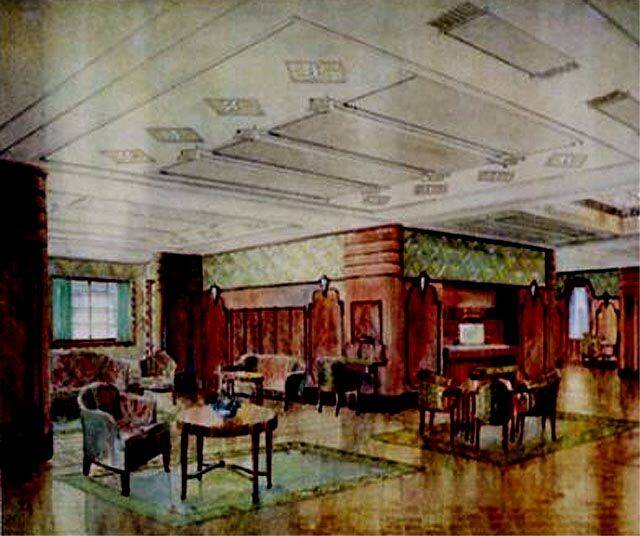
The artist
is the wonderful Mr. J.H. Sikemeier
Hallway & Promenade Deck:
Aft of the Smoke Salon on both sides of the Main Stair Well are the Doors that head out to the Second Class Promenade Deck. Although this open sided section is relatively short, for the section directly aft is reserved as the children’s play deck.
Yet, this deck remained very popular with the Passengers, as in the evening it was the perfect spot to come out with a drink and look out over the water and look at the moon, etc and chat! And during the day there were ample tables and chairs for relaxation and reading a book or have a chat!
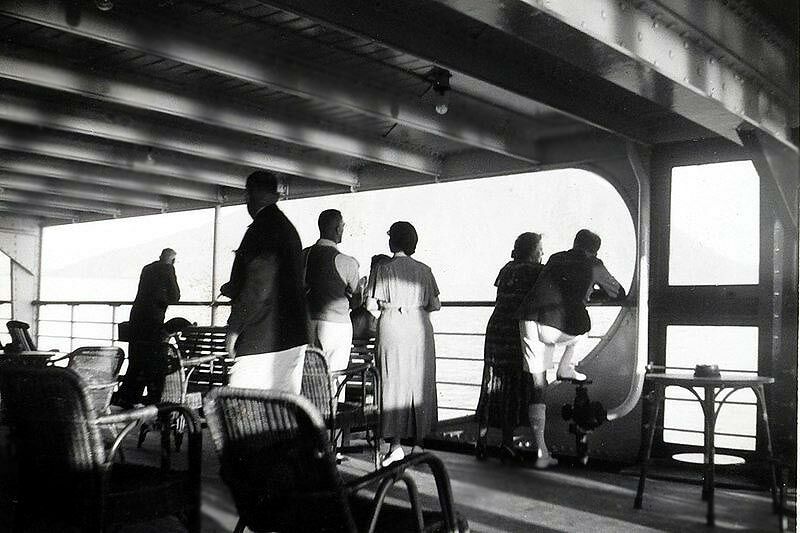
Promenade Deck starboard side
Children’s Play Room & Play Deck:
Children were always very well cared for, and their facilities were simply excellent, regardless of class. Their Playroom was located aft of their Play Deck, and it was like the first Class facility fully equipped with every possible need, and had qualified nurses and Indonesian steward to look after the children with great care!
Again they would dine in their venue and be given various snacks and other goodies to keep them very happy indeed!
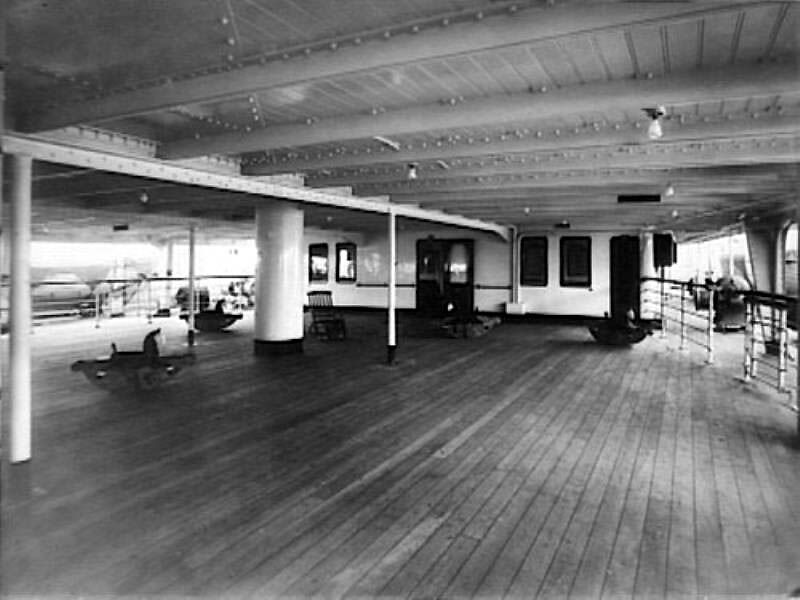
Here we see the
Children’s Play Deck and the door into their Play Room
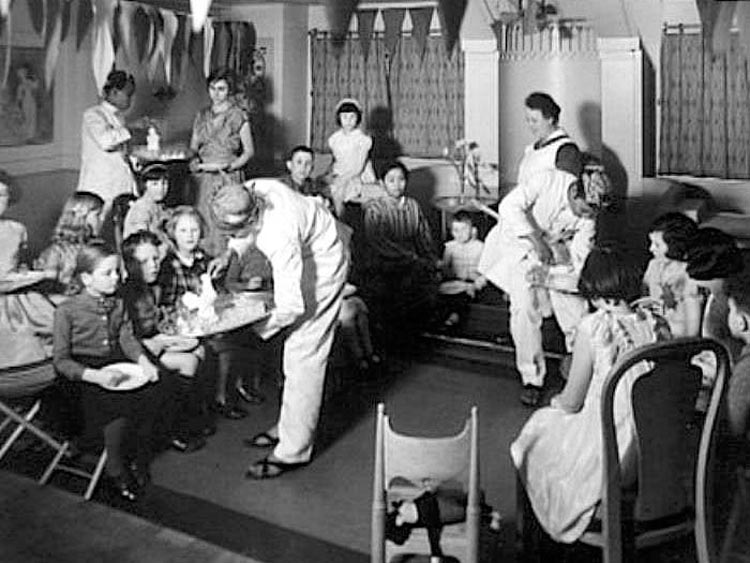
Nurses, stewards are always present and parents are also always welcome, as we can see here
Upper (C) Deck:
Accommodations:
This deck contains some forty four cabins, these are from two or three to four berth cabins, although there are a number of interchangeable cabins available between First and Second class pending the need.
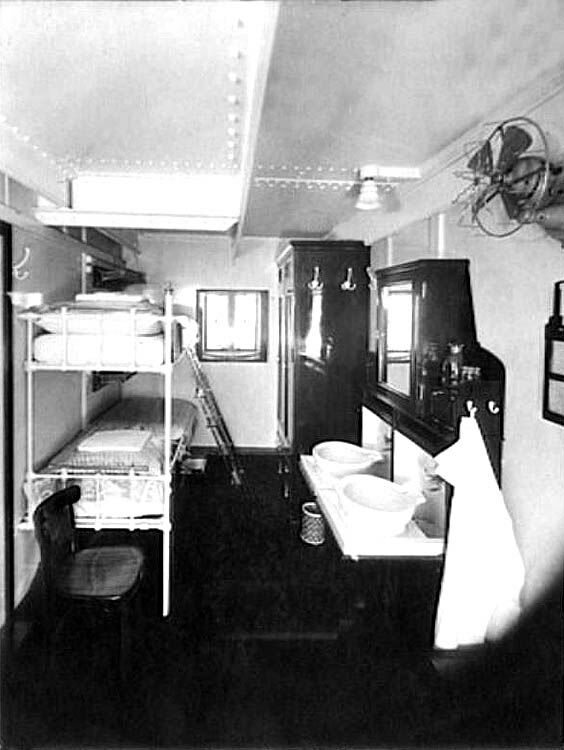
Here is a two
berth cabin
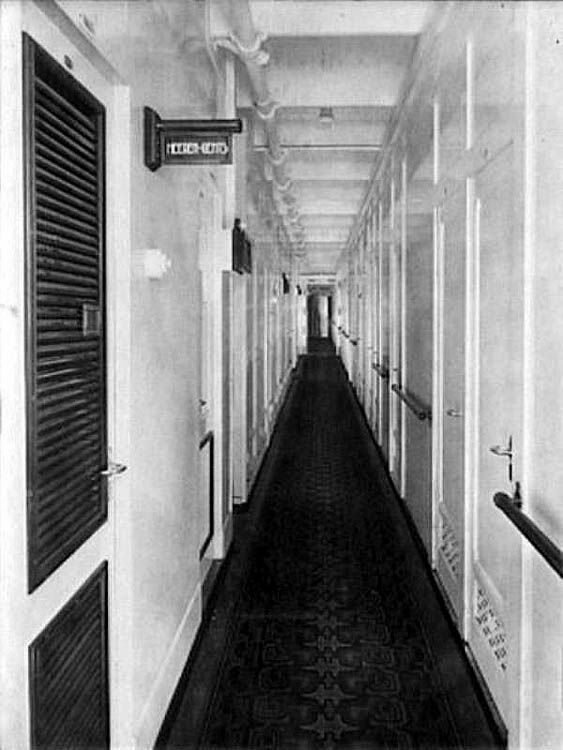
And a hallway along the cabins portside looking aft
Of course as you can see all the public facilities are located on the inside (left)
Shelter (D) Deck:
Entrance Hall & Dining Room Dome:
If we take the Main Stairwell down (between the Smoke Salon and The Social hall) down to this deck, we arrive at the main Hall, which is the main Entrance Hall when passengers board her, and they will be greeted by the beautiful timber balustrade and it looks down into the Dining Room of the Second Class, which is a beautiful venue.
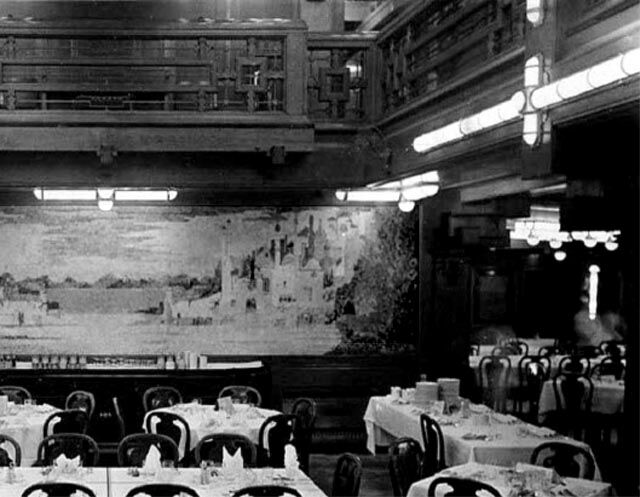
Here is a glimpse of this beautiful venue
On the starboard side forward of the entrance door were both the hairdressers, and aft of the doors the Pursers Office. The rest of this deck is occupied by mostly two or three berth cabins.
E Deck:
Dining Room:
The Grand Staircase ends in this fine Dining Room and the first thing that stands out is the huge mural on the forward centre wall above the buffet. The venue follows the rest of the ships décor, with the use of walnut panelling and furniture, etc making this dining room a most elegant venue to dine in!
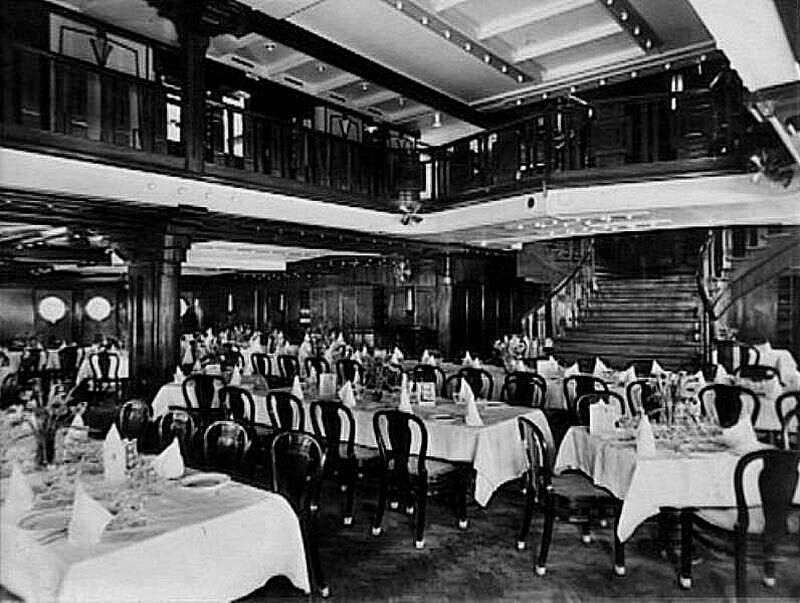
The Dining Room
looking aft
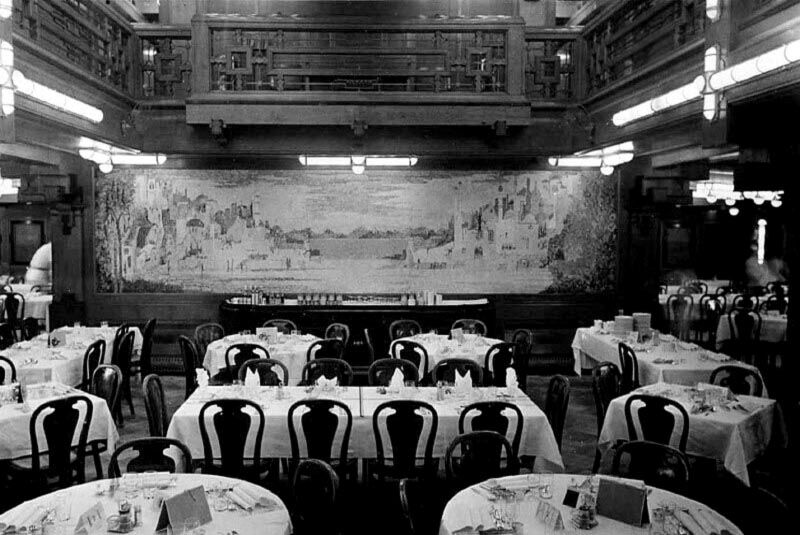
And here we see the venue looking forward to the mural
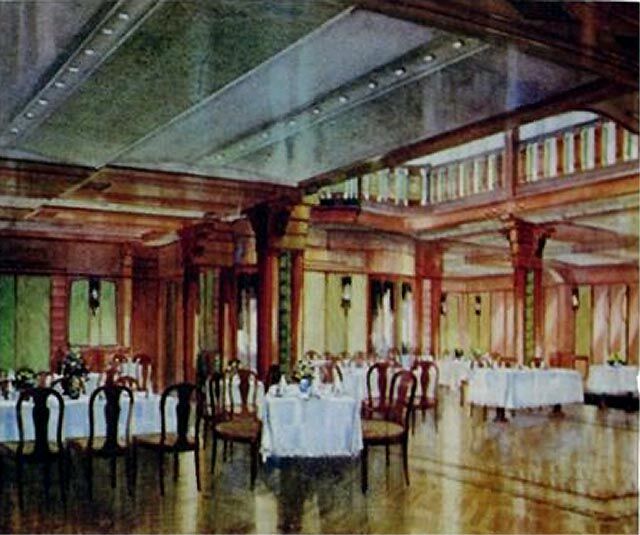
An artist impression of the Second Class Dining Room
The artist
is the wonderful Mr. J.H. Sikemeier
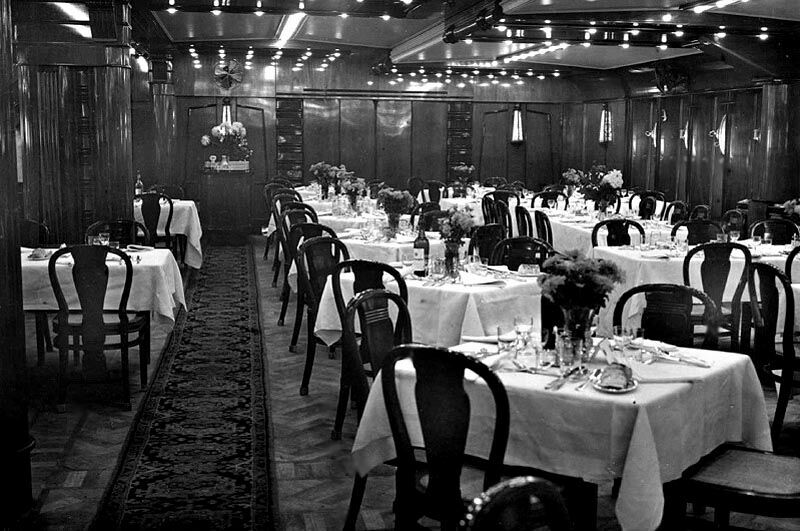
The starboard side
of the Dining Room
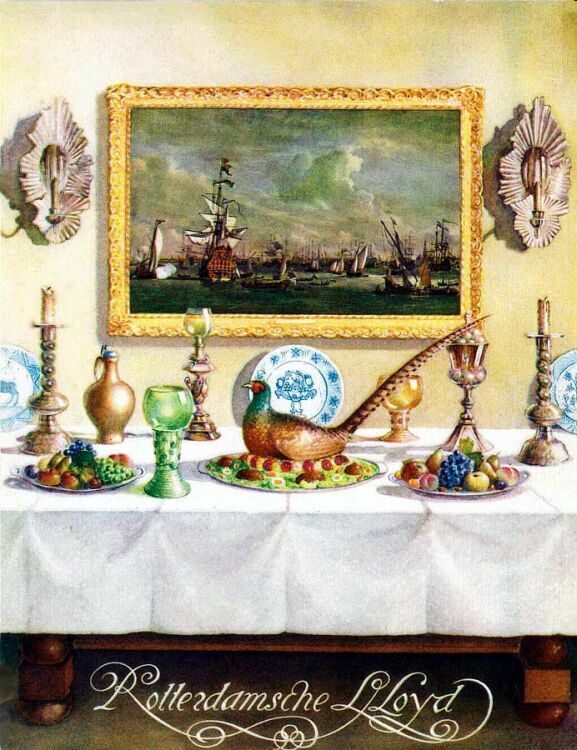
Above & below: A Diner Menu for May 19, 1935
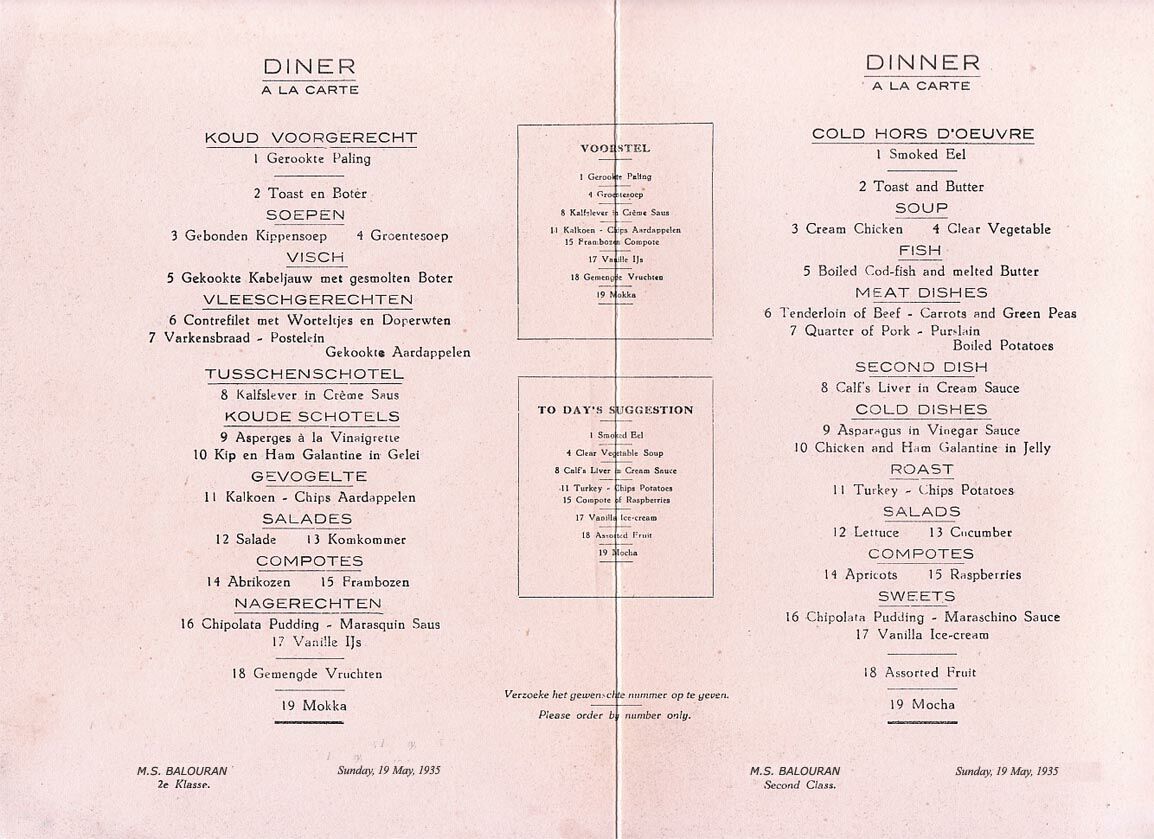
Aft of the Dining Room
there were 36 two and three berth cabins, and this completes the Second Class
section and we will now take a brief look at Third and Fourth Classes.
Third Class:
Upper (C)
Smoke Room & Promenade Deck:
Sadly, I do not have photographs of the Third or the Fourth Class. But Third Class would have been quite pleasant, I am sure. Located on Upper Deck was their Smoke Room and the Bar, which was the perfect size for her 30 passengers and it could seat all the guests she accommodated after her refit 1937, and for interest the Deck Plan I happen to have is from that date. Outside there was a very spacious undercover open sided Promenade Deck.
Dining Room:
On Shelter (D) Deck there was only their Dining Room which accommodated all guests at one sitting. There were facilities aft of the venue on both sides. This venue could also be used for other purposes, such as a place to relax and as a lounge in the evening.
Accommodations:
On E Deck there were just four cabins 2 two berth cabins and 2 three berth cabins, whilst on F Deck there were 22 cabins making up the rest.
Forth Class:
Shelter (D) – E Deck:
This Class is located far forward in the Bow section directly under the Foc’sle, and located on Shelter Deck forward of the superstructure there was open deck space for the passengers, and inside the forward section there was their “Deckhouse” on the starboard side, being their lounge, Smoke Room, Bar and Dining Room, etc. Whilst on E Deck all cabins were the most basic rooms with six bunks. Forward of the cabins on the starboard side was a hairdresser, but he was only available at certain times, but thankfully there were toilets on this deck, but the showers were up on Shelter Deck.
*********************
Several Incidents:
During the first years of service, the Baloeran was involved in several accidents.
On March 18, 1931 a collision occurred near Tandjong Priok between the M.S. Baloeran and the 5,310 GRT M.V. Silverbeech of 1926, being a British cargo ship.
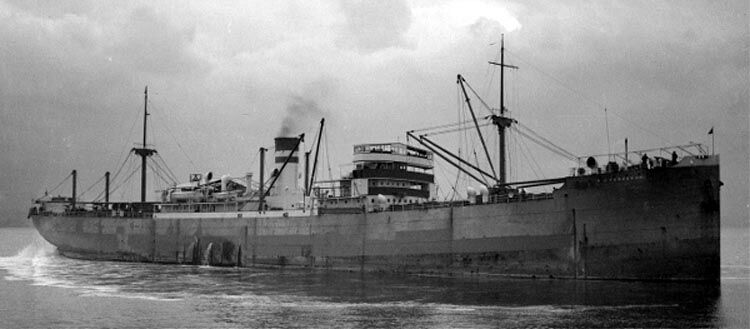
The M.V. Silverbeech
The Baloeran sustained
some damage to her starboard side but was able to continue on to
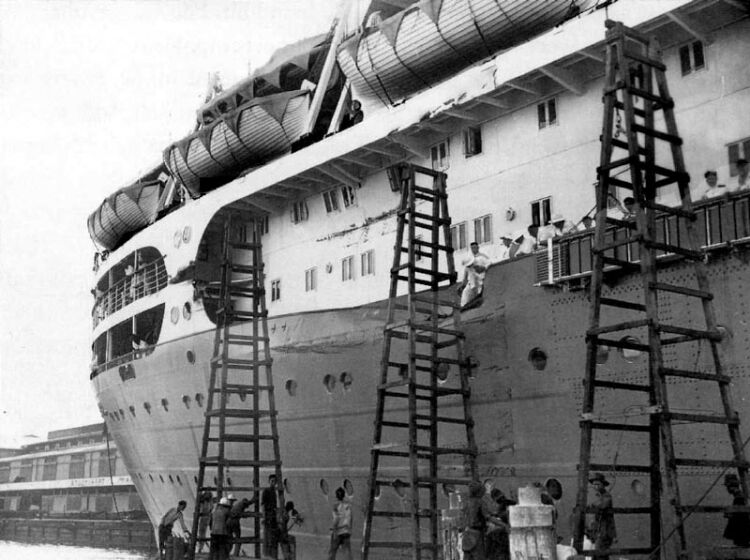
Here we see the dent to her starboard side which was repaired here at Sourabaya
Then on January 28,
1932, the “Baloeran” somehow ran aground in the “Nieuwewaterweg”, (the canal between
Publicity Items, Schedules & Other items:
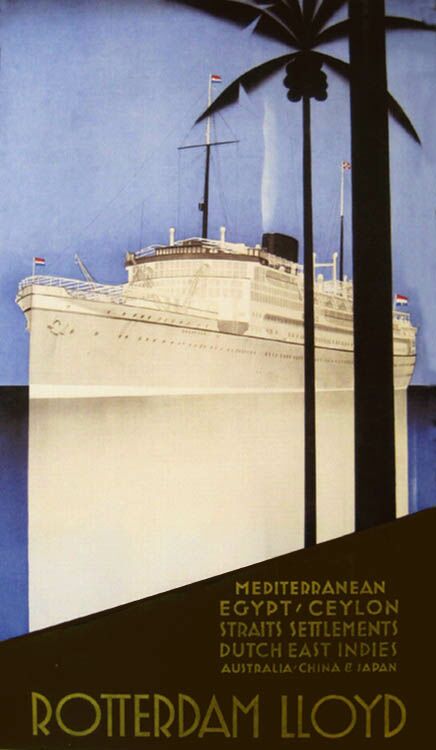
This is a
‘Rotterdam Lloyd’ Publicity Poster of the M.S. Baloeran and her new
1931 sister the “Dempo”
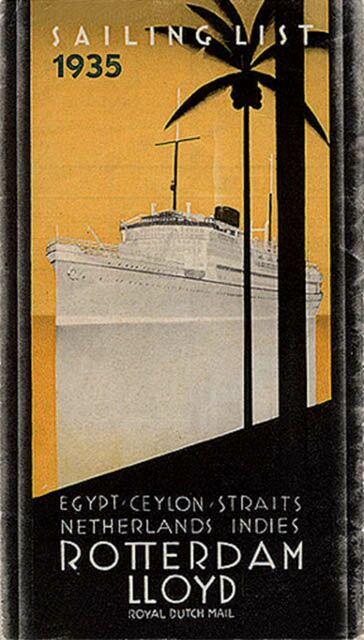
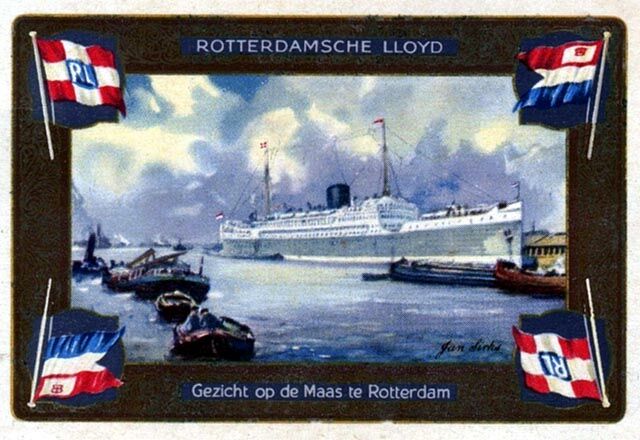
The back of the ships playing cards, which could also be obtained as a souvenir from the shop
It states at the
bottom; “View of the Maas (River) at
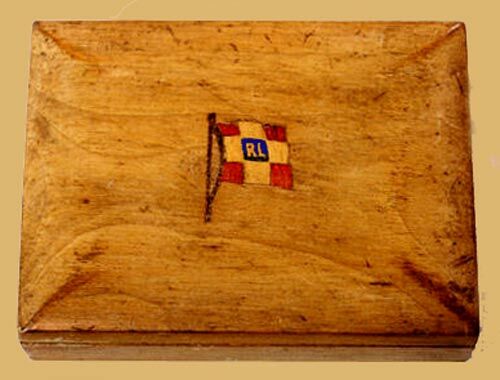
A timber ‘Rotterdam Lloyd’ Cigarette box originally owned by a crew member
A Special Passenger joins the Ship:
M.S. Baloeran continued
her regular voyages and in 1935 she departed on one of her sailings on May 27,
and she departed
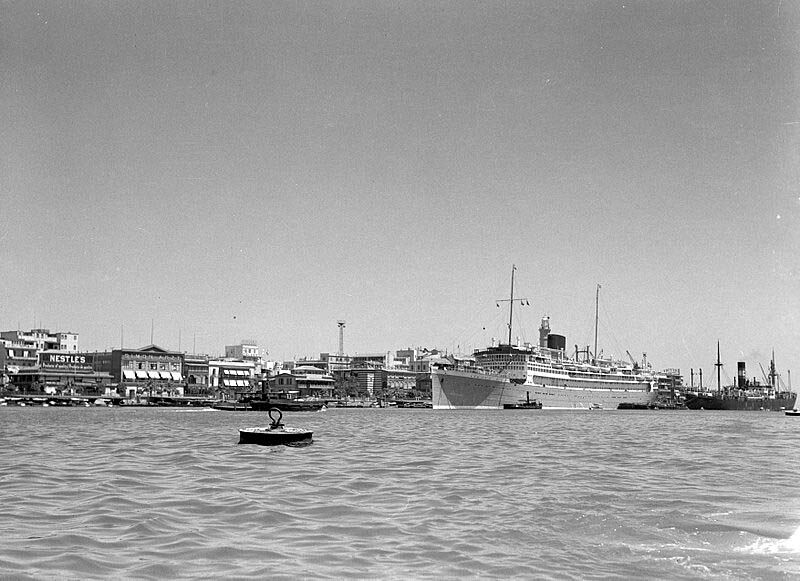
The M.S. Baloeran
is seen at
However, during that
voyage the “Baloeran” had a very special passenger, being the
‘Sultanah Helen Ibrahim’,
whose husband was Sultan Sir Ibrahim Iskandar Al-Masyhur ibni Almarhum (Sultan Sir Abu Bakar), being the 22nd Sultan of Johore,
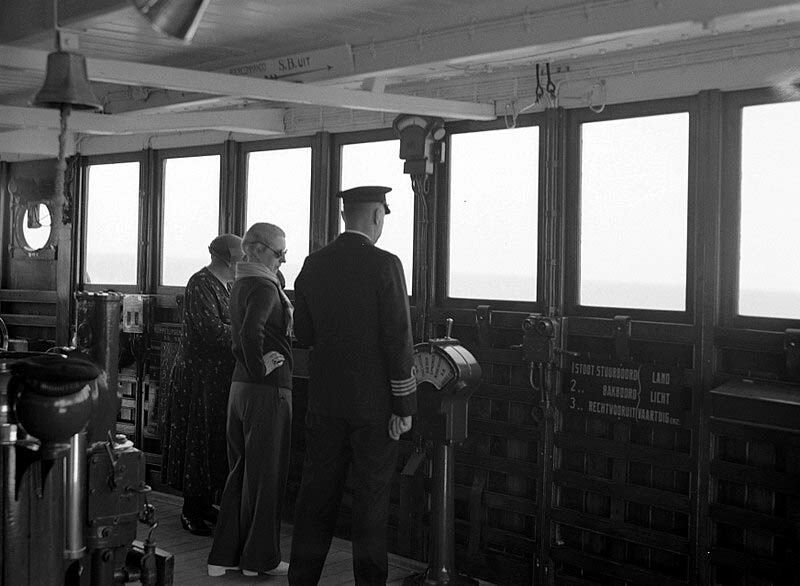
Above & below: Captain Dubois and the ‘Sultanah Helen Ibrahim’ are seen on the Bridge
As the two photographs show she spent some time with Captain A. Dubois on the Bridge, and she also enjoyed the company of lady who she had met on board and had invited and they had a drink together out on deck just aft of the Bridge, away from the passengers. She would have obviously occupied one of the Deluxe Suites forward on Upper (C) Deck.
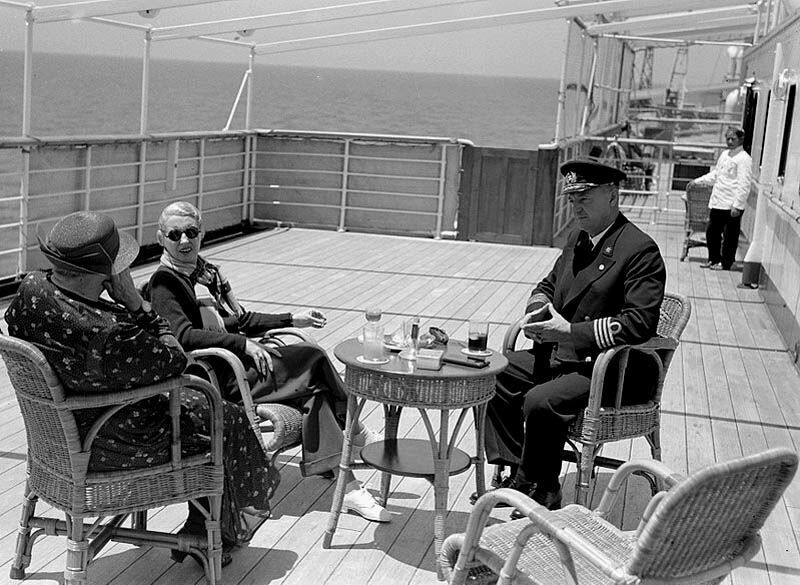
An Extensive Refurbishment:
In 1937 the M.S.
Baloeran was given an extensive modernisation of her First Class cabins at a
Please Note: When the plan opens it will come up as a small image, just click on
it when it has fully loaded and it will expand to its full size, when finished
use the back arrow (top left
of your screen) to return to the page.
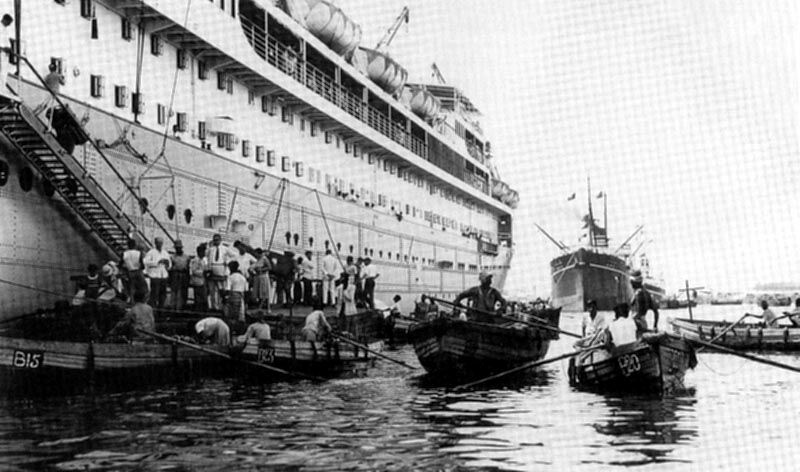
The
“Baloeran” is seen at anchor at
*********************
Her Final Liner Voyage:
Her next voyage was to
be her thirtieth return voyage, which was under the command of Captain A. Dubios and the M.S. Baloeran departed
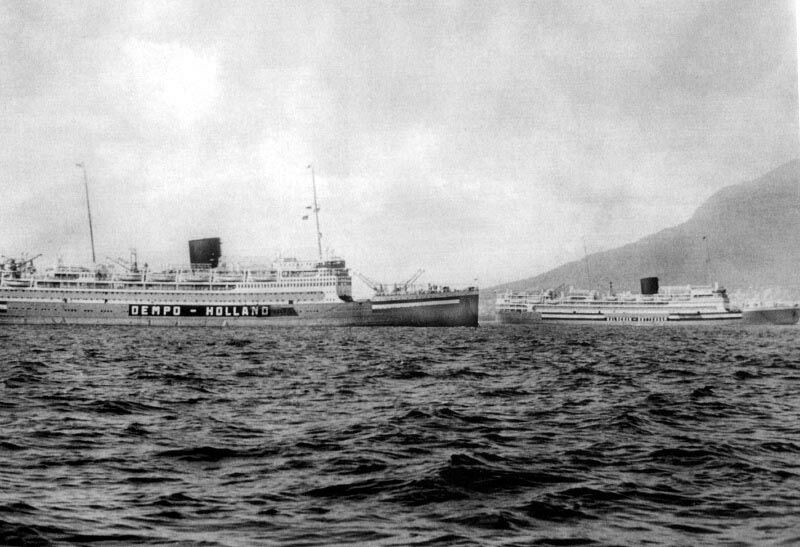
The M.S. Baloeran
(closest to
in September 1939, during their very last ever passenger voyage, for both will be lost during the war
Before returning to
Rotterdam, the “Baloeran” had to call in at London, but shockingly
the M.S. Baloeran was rather very badly treated by the British authorities to
say the least, it was if the Dutch were the enemy; The Captain stated: “All
our cargo was seized (in fact it was stolen) in London consisting of the
following goods: copra, rice, fibres, hides, rubber, kapok, tin, sugar and palm
kernels”. Thank you
And due to the Brits doing this, the “Baloeran” was greatly delayed reaching her home port very late thus costing the “Rotterdam Lloyd” a small fortune. Having had her passengers disembark, she was laid up.
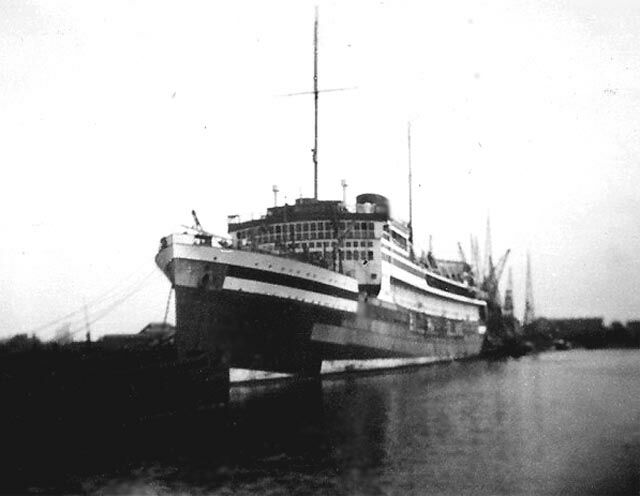
“Baloeran”
is seen in a lay-up condition in
Although the
During the outbreak of World War Two M.S. Baloeran had been laid up in Rotterdam, but with the Germans having invaded the Netherlands and of course the port of Rotterdam they used the “Baloeran” as a temporary Power Station.
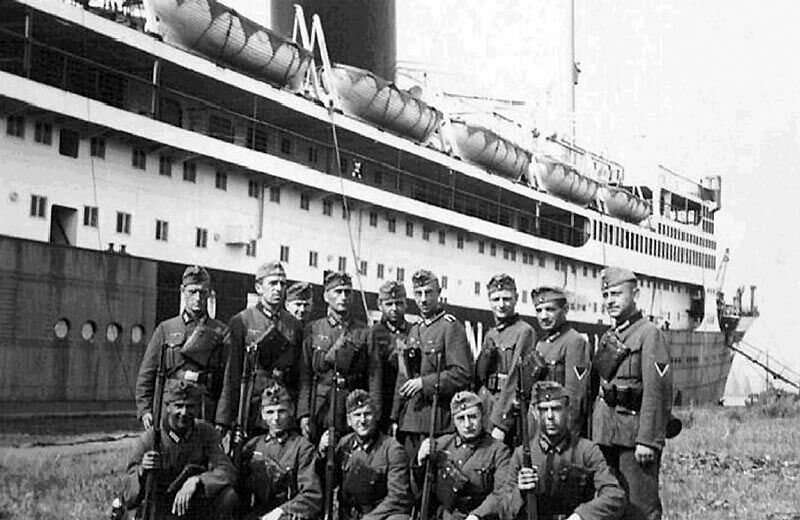
The once beautiful “Baloeran” stolen by these Nazis and used as a Power Station
Baloeran officially seized by the German Navy:
Of course the M.S. Baloeran was soon captured and the “Kriegsmarine” and they used the “Baloeran” during the first part of the war as a power station to contribute to the electricity needs of the occupying forces in the port of Rotterdam, whilst her First Class was also was used as a hotel, and her other facilities to accommodate German soldiers stationed in the region.
Therefore they had made some minor necessary changes to the layout of the ship, for example her saloons and cabins were made larger, and thus it had to be more spacious in order to make them more suitable for the use as a German lodging house.
During the period the
“Baloeran” was in use as a power station and berthed at the
Waalhaven, they had her towed to the
From Baloeran to Strassburg:
The Germans had decided they needed her as a “Lazarettschiff” (a Hospital ship) and thus she required to be refitted, which would be done again at the Wilton-Fijenoord shipyard and the ‘Kriegsmarinedienststelle’ (War Naval Service) had her in the yard on May 10, 1941. The renovation lasted until July 20, 1941, and they renamed the ship “Strassburg”. The “Strassburg” now had space for 500 patients and she would have 161 medical staff. When she was completed, for convenience they used her original IMO number.
She had been painted
all white, with the full Red Cross Livery of a Green wide band around her hull
and the large Red Crosses. This of course laid claim for her to be exempted
from war aggression, and this implied that: the ship had to be nominated by the
country concerned for commissioning as a hospital ship and had to be registered
with the International Red Cross in
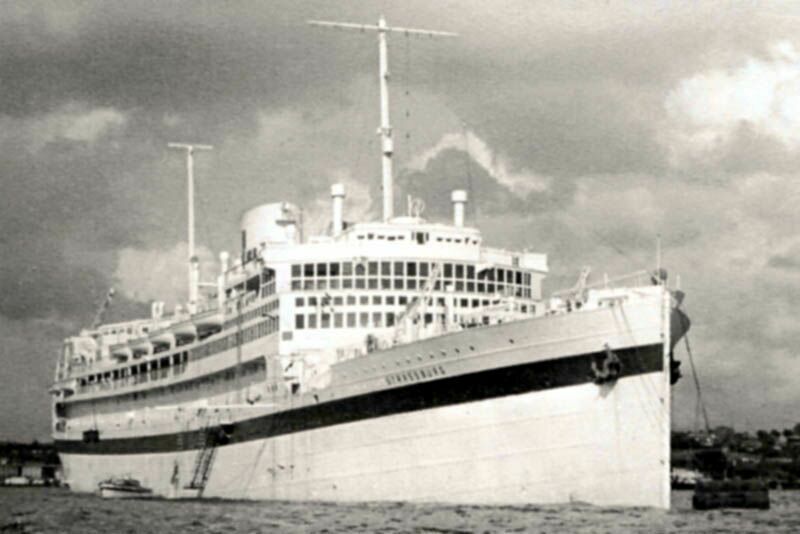
The
She was managed by
‘HAPAG’ or the “Hamburg-America Line”, who crewed her with 150 Germans who were under the command of
Capitan Lehmann. Once she commenced her duties she
mostly operated between
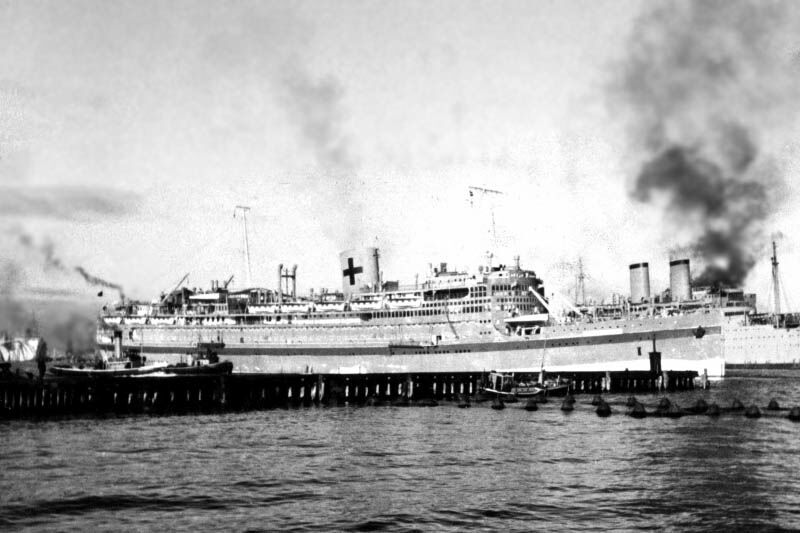
The “Strassburg” is seen at
The
“Strassburg” besides operating to the northern parts of Europe, she
would also visit
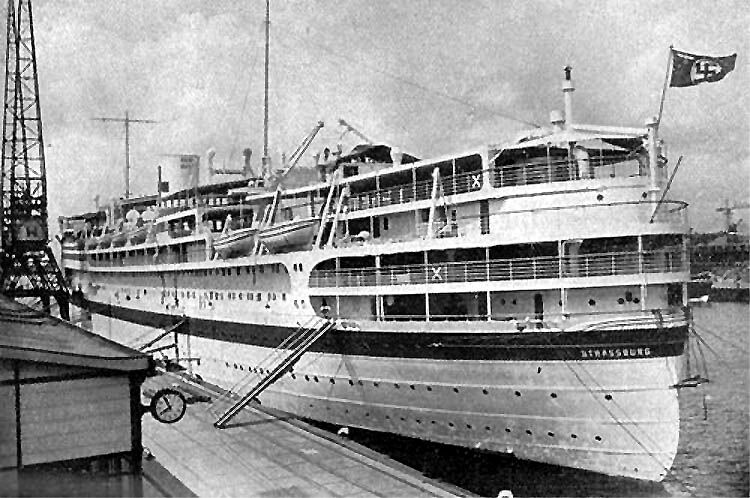
She is seen in
Early in 1942 she was
again sent to
Yet these Nazis decided to keep the green band around her hull, but the ship no longer resembled an official Red Cross accredited hospital ship, but then she never officially fulfilled their requirements anyway, for they like typical Nazis cheated. And you may ask how? That is very simple; she had ‘FLAK’ anti-aircraft guns mounted all over her, and hospital ships are not permitted to have any kind of armaments at all. Thus she was an illegal ship, pretending to be a Red Cross Hospital ship from day one!
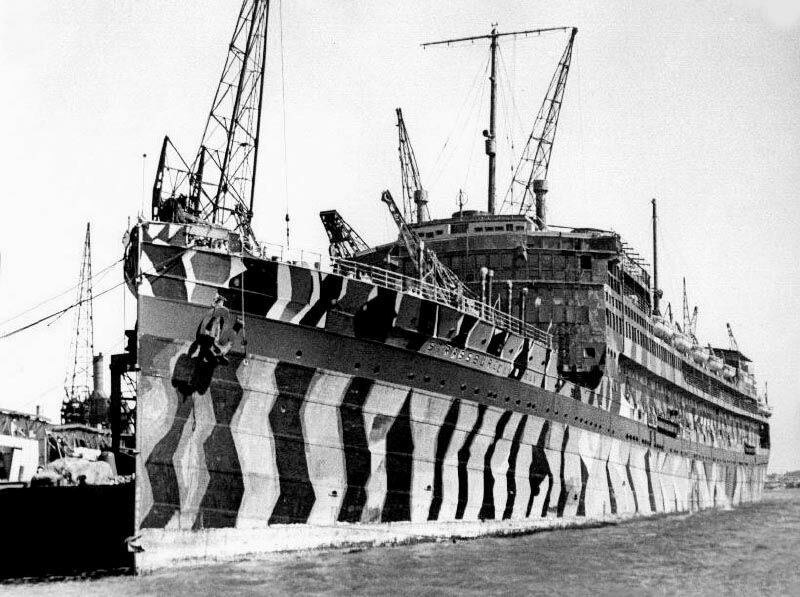
A hideous evil looking ship, just like the people who now operated her
The End of the “Strassburg”:
On September 1, 1943,
at 00:30 hours, the “Strassburg” collided with a mine off
Because of the explosion, the engines immediately stopped and a great deal of water flowed into the engine room and hold 3. The ship commenced to list rapidly to 40 degrees. And soon panic broke out among those Krauts who were so frightened for they believed that it must have been a torpedo attack, thus they fled in great speed in their lifeboats, and they made no attempt to plug the leak down in the engine room.
From the escort vessels, struts and bracing crews saw the running scared crew, but they immediately boarded the “Strassburg”, and they went and plugged the leak, they were very happy as the ship heeled and straightened. Even though hold No 3 was mostly submerged and the seawater had also penetrated to other areas, they made further attempts to save the ship. A tow was even attempted, but that failed as the cable broke considering the ship being far too heavy to tow. Several sea-going tug finally arrived, but it was decided to beach her on a sandbank 1.3 miles northwest of the “IJmuider Noorderhoofd” (The Heads) to stop her from sinking, but she did partially sink water up to the main deck, at the position 52°29'N and 4°32'E.
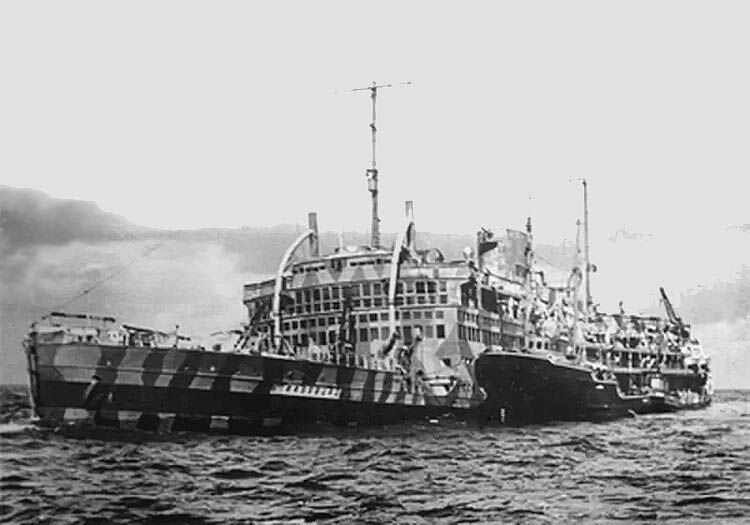
The “Strassburg” is seen after the mine incident and she is on that sandbank
British attacks on the “Strassburg”:
The next day September 2, there was a RAF three RAF Beau fighters of the Coastal Command carried out an air raid on the “Strassburg” during daylight, with 2 bombs hitting the ship, knocking out the main FLAK gun on the ship. Whilst over the next few days, as much as possible of the medical inventory was taken from the ship, and they again attempted to raise and rescue the ship, without any success.
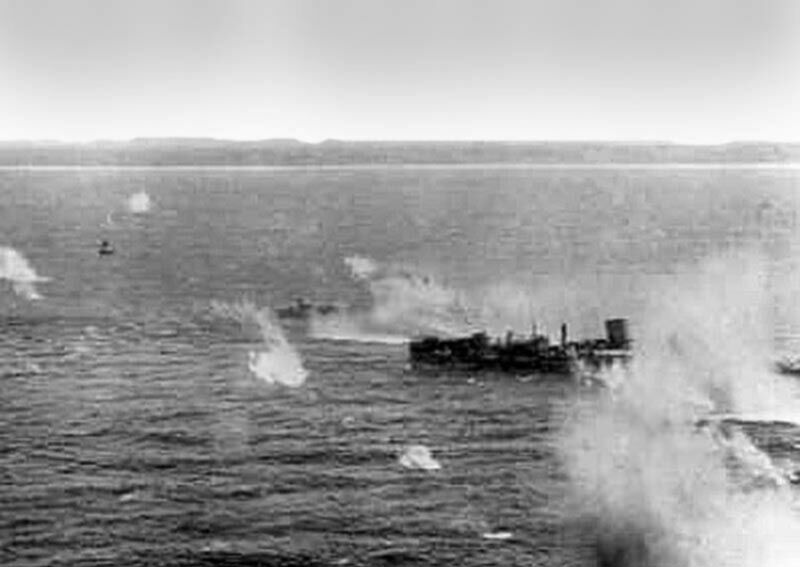
RAF Attack on the “Strassburg” on September 2, 1943
On September 6, 1943, it was decided to actually give her up. Although then there must have been a change of mind, as they decided maybe not quite yet, for the Kriegsmarine then placed smaller armed vessels around her for protection, as they probably hoped to raise her later.
However, on this very
same day, the ship was observed by an observer on a British Coastal Command
aircraft. He saw the half sunken ship lying in the North Sea, just a few
miles west of the
On September 17, Coastal Command scouts flew over the “Strassburg” and noted the helpless condition the wreck was in, despite the Kriegsmarine vessels protecting the wreckage.
Before the afternoon of September 19, 1943, a combined unit of 4 Motor Torpedo Boats and 3 Motor Gun Boats departed from their home port of Yarmouth, England, with the order ‘Search and Sink’ or ‘Go along the Dutch coast in search of loot and drill it into the ground’. This unit fired 2 torpedoes below the waterline at the Strassburg, confirming that the fleet commander MBT 617 had received the final shot.
This was followed up the very next day on September 20, when the German ship was again attacked by British bomber planes and this time she was severely hit and she soon caught fire and this time she was partially sunk at 52°29'15 NB - 4°32'04, she was now completely wrecked and could not be salvaged.
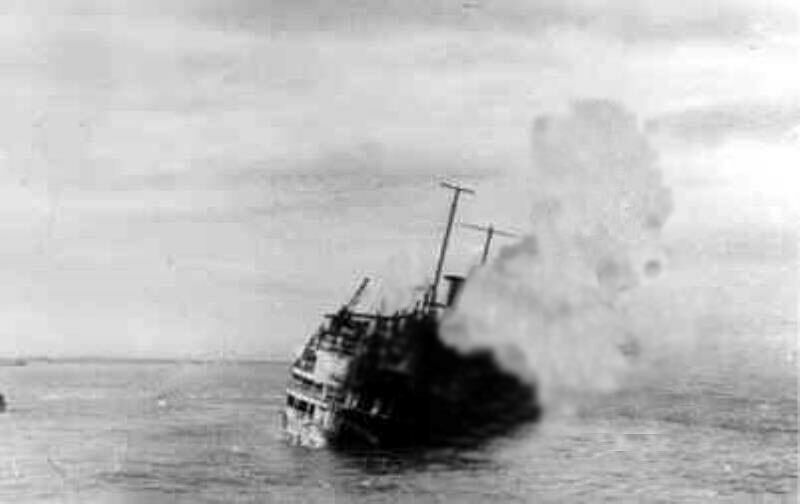
A sad sight, even though she was a German ship now, but she was still that
remarkable Dutch Liner the wonderful M.S. Baloeran, thus a sad sight indeed!
During this final attack some 7 people were killed for not only was the “Strassburg” was set alight but also 3 of the ‘Kriegsmarine’ ships had been severely damaged and 5 Krauts died and 8 were severely wounded. The other 2 deaths must have been sadly among the British from Nazi return fire. The “Strassburg” (the ex M.S. Baloeran) was finally officially given up by those evil Nazis!
The wreck of the
Baloeran is located close to
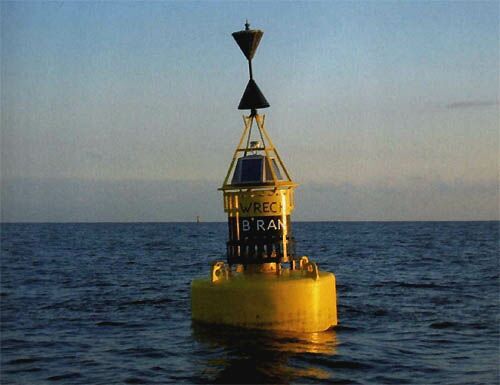
The Buoy locating the ex M.S. Baloeran
The remains of the once proud Rotterdam Lloyd Liner is now an object for the occasional recreational divers, and a beautiful bronze plaque was created after the war to honour the remarkable “D.S. MAILMOTORSCHIP BALOERAN”.
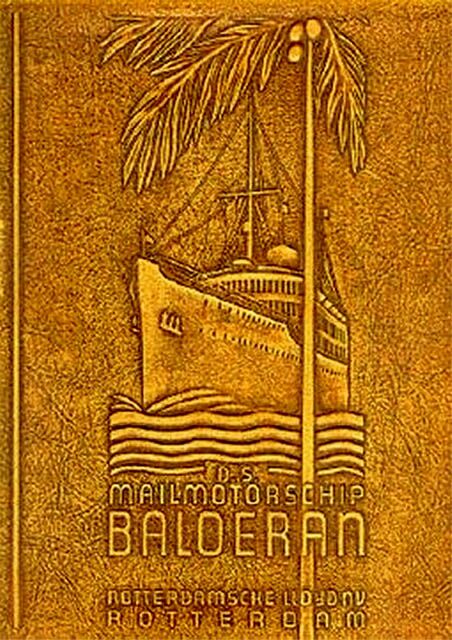
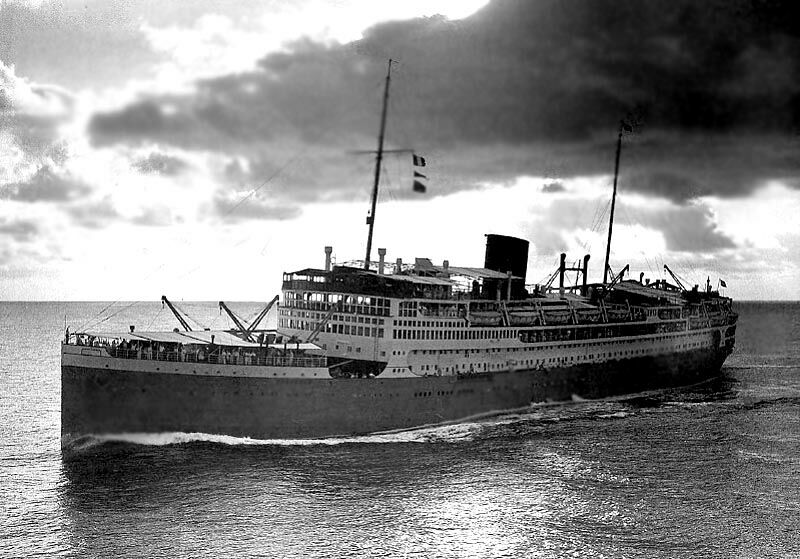
The delightful
M.S. Baloeran is seen at Sea
*********************
M.S. Baloeran Specifications & Details:
Names: 1. Baloeran - 1930 to 1940.
“ 2. “Strassburg” - 1940 to 1943.
Owner: 1.
“Firma Wm Ruys & Zonen”,
“ 2.
“Deutsche Kriegsmarine”,
Managed
by: 1.
“
“ 2.
“
Registered
at: 1.
“ 2.
Ordered: May 10, 1928.
Builder: Fijenoord
N.V.”,
Laid Down: August 26, 1928 at “Fijenoord N.V.”.
Yard N°: 313.
Named & Launched: August 29, 1929.
Trails: March 22, 1930.
Completed & Delivered: April 9, 1930.
Maiden Voyage: April 16, 1930.
. All other details are re the “Baloeran”.
IMO: 5607207.
Call Sign: NGJS.
1934: PCXW.
Category: Passenger vessel.
Route:
Tonnage: 16,981 GRT, 10,062 NET, 8,740 DWT.
1937: 17,001 GRT.
Length: 168.98 m - 554.39 ft.
1937: 175.05 m - 574.31 ft after refit & lengthening.
Beam: 21.45 m - 70.37 ft.
Draught: 9.10 m - 29.85 ft.
Engine: Two single acting 10 cylinder De Schelde Sulzer 10ST76 2 cycle engines producing 7,000 HP each at 100 RPM.
Auxiliary engines: Four x 6SS38 engines totalling 3,120 hp at 170 rpm.
Engines built by: NV De
Schelde Machinery Factory, Flushing (
Screws: 2.
Speed: 18 knots service speed, 18.8knots maximum.
Accommodations: 262 First Class, 266 Second Class, 70 Third Class and 68 Fourth Class. 666 total.
1937: 236 First Class, 253 Second Class, 30 Third Class and 68 4th (Steerage). 587 total. (There were 27 interchangeable cabins between First and Second Class).
Crew: 335 (Dutch, Indonesian & Chinese).
“ 330 from 1937.
Cargo: Grain - 417,336 Cubic Feet.
“ Bales
- 356,697 Cubic Feet.
Rotterdam Lloyd Index - Ships are in order of their year of construction:
MS Indrapoera … Completed
in 1926 to 1957 and sold, sailing on to 1966. (Online
Soon)
MS
Sibajak … “ in 1928 to 1959 this is an 11 page
feature
MS
Baloeran … “ in 1930 and she was sadly bombed in
September 1943.
MS Dempo … “ in 1931 and was sadly torpedoed in March
1944.
MS Willem Ruys …
“ in 1947 and sold to become the ‘Achille Lauro’ until 1994.
Netherland Line Index – Ships operating
on the New Zealand – Australia service:
MS Johan van
Oldenbarnevelt … Completed in 1930 to 1963
sold to become the ill-fated Lakonia destroyed by fire in 1963 at sea.
MS Oranje …
“ in 1934 to 1964 sold to become the Angelina
Lauro until 1979
*********************
R emembering the Delightful
M.S. Baloeran
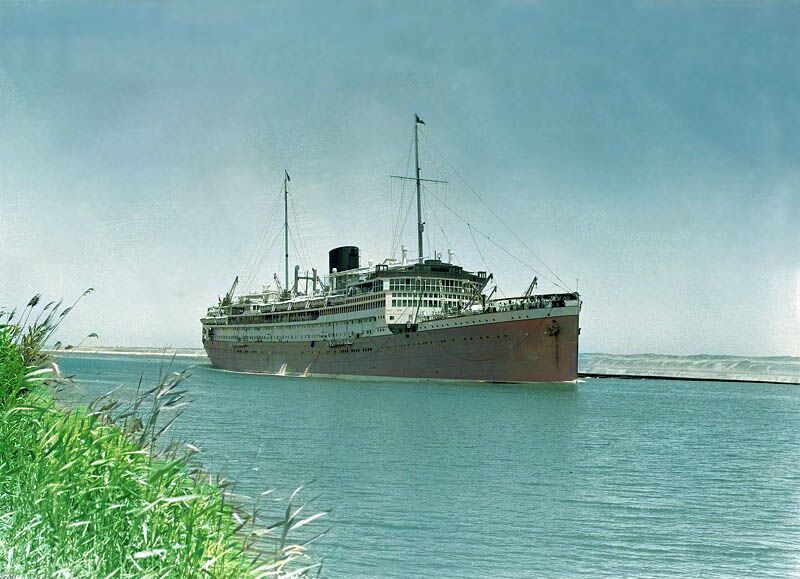
M.S. Baloeran is
seen in the
*********************
“Blue Water Liners sailing to the distant shores.
I watched them come, I watched
them go and I watched them die.”
Featuring over 1,435 Classic Passenger Liners, Passenger-Cargo Liners & Classic Cruise Ships!
Or ENTER HERE
For interest: Sadly an email service to ssMaritime is no
longer available, due to the author’s old age and chronic illness as well
as being disabled, etc. In the past ssMaritime received well over 120 emails
per day, but
*********************
ssMaritime.com & ssMaritime.net
Where the ships of the past make history & the 1914 built M.S. Doulos Story.
The Author has been in Passenger Shipping & the Cruise Industry for well over 60 years
In addition he was the founder of “Save the Classic Liners Campaign” in 1990.
Please Note: ssmaritime and associated sites are 100% non-commercial and the author seek no funding or favours of any shape or form, never have and never will!
Photographs on ssmaritime and associate pages are by; the author or from the author’s private collection. In addition there are some images that have been provided by Shipping Companies and private photographers or collectors. Credit is given to all contributors. However, there are some photographs provided to me without details regarding the photographer/owner concerned.
This notice covers all pages; although, and I have done my best to ensure that all photographs are duly credited and that this notice is displaced on each page, that is, when a page is updated!
ssMaritime is owned
& © Copyright by

